The Cobalt-Gowganda Silver mining area (Cobalt Camp) of Ontario was one of the most prolific silver mining areas in the world. Over 600 million troy ounces of silver have been produced from mines in the area since the first vein was discovered in 1903. I am fortunate to have visited this historic area many, many times over the years. My first visits were when I actually lived there, while attending the Haileybury School of Mines, in the mid-1970’s. It was easy for us to hitch-hike or drive the few miles from Haileybury to Cobalt and wander around in the woods looking for old mine dumps, silver and arsenide specimens, building foundations and the head frames that were still standing.
In 2012, I was fortunate to have co-authored an article published in the Mineralogical Record (Volume 43, #6), with staff from the Royal Ontario Museum, that should stand as a significant reference about the mines and minerals of the Cobalt Camp. This article will no doubt have some overlap but will also introduce a more personal review of my experience with this fascinating mining and collecting area. As well, I will try to feature additional pictures of interesting mineral specimens that have never been published before from my and others’ collections. Unlike the article In the Mineralogical Record that features many specimens that were recovered from active mines in the “heydays”, never to be seen again, many of the specimens featured in this article (not all) were found recently and similar specimens could certainly be found again.
Cobalt is located due north of Toronto and is about a six hour drive on good paved roads from Toronto. The silver mining area is located, mostly, on the western shore of Lake Temiskaming, in Ontario, on the border with Quebec, although some of the mines were located further away near Gowganda, New Liskeard and Elk Lake.
General Geology
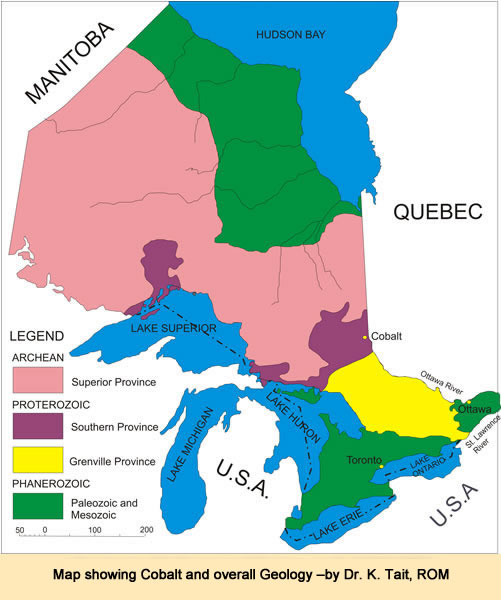
The silver deposits of the Cobalt-Gowganda area occur along the northern and eastern margins of the Southern Province in an area referred to as the Cobalt Embayment. The term Embayment derives from the overall “bay-like” shape of this large, approximately 11,580 square miles, an area which is bounded on the north and east by Archean basement rocks and to the southeast by the Grenville Front (Figure 8). A small outlier of Paleozoic strata is preserved at the north end of Lake Timiskaming.
The area is underlain by Early Proterozoic rocks of the Huronian Supergroup which rest unconformably on Archean granitic, metavolcanic and metasedimentary rocks of the Superior Province. The Huronian Supergroup consists of an assemblage of sedimentary and minor volcanic rocks deposited between 2500 and 2220 million years ago and is subdivided into four stratigraphic groups which in ascending order are: the Elliot Lake, Hough Lake, Quirke Lake and Cobalt Groups.
In the Cobalt-Gowganda area the Huronian sequence consists of a variety of essentially flat lying coarse to fine grained clastic sediments of the Cobalt Group which have been subdivided into the Gowganda, Lorrain and Gordon lake formations. The Gowganda formation is subdivided in to the Firstbrook and Coleman members, the Coleman member, predominately conglomerate, laminated siltstone and sandstone, being the most important sediment host to the silver vein deposits. Archean basement rocks are exposed within the Cobalt Embayment as isolated inliers and both the sediments and basement rocks have been intruded by sills and dikes known as the Nipissing diabase. Corfu and Andrews (1986) report a U-Pb baddelyite age of 2219.4+-4 Ma for Nipissing diabase near Gowganda but because of its widespread occurrence throughout the Huronian Supergroup it is not known whether these intrusions occurred as a single event or in stages over a considerable period of time. Compositionally an olivine tholeiite the Nipissing diabase occurs as a suite of gabbroic sills and steeply dipping dikes and plugs. The sills, more accurately described as undulating sheets, maintain a relatively uniform thickness of 980-1100 feet.
Structure
Three major regional scale fault trends occur within the area. They cut all the rocks in the Cobalt Embayment and extend for hundreds of miles cross-cutting the Grenville Front to the south and the Archean basement to the north. Although mineralized veins do occur in these faults they are also found to cross cut them and most regional faults are barren. No clear relationship has been established between the veins and these regional scale faults (Jambor, 1971a).
Metamorphism
The oldest Archean rocks consist mainly of intermediate to mafic, massive and pillowed volcanics and minor pyroclastic and interflow sediments. These rocks were intruded by Archean granites followed by minor mafic, ultramafic and lamprohyric dikes and sills. The metavolcanic-metasedimentary rocks subsequently underwent a regional greenschist-facies metamorphic event and were isoclinally folded. The Huronian strata are mainly flat lying and very well preserved and only exhibit a sub-greenschist-facies assemblage.
Associated with the Nipissing diabase and interpreted to contact metamorphism is an alteration referred to as “chlorite spots or spotting.” Developed mainly in Huronian sediments it also occurs in Archean mafic metavolcanics and mafic plutonic rocks. The alteration appears as dark green spherical, between 0.04-0.20 inches in diameter, aggregates mainly composed of chlorite. Confined to the northeastern portion of the Cobalt Embayment and extensively developed in the Cobalt-Gowganda camp the alteration is highly erratic in its occurrence but is found within 490 feet of Nipissing diabase contacts. Although there appears to be a spatial relationship between “chlorite spotting” and ore veins evidence, in particular the observation that ore veins cut through rocks exhibiting chlorite spots, they are considered to have resulted from two separate events (Jambor, 1971c and Andrews et al., 1986).
Character and Distribution of Ore Veins

The veins occur in a variety of rock types, Huronian sediments, mainly Coleman member, Nipissing diabase, and Archean metavolcanics and metasediments. Ore veins have also been found in Archean granites and late lamprophyre dikes. The ore veins vary in width from a few inches to over 12 inches with an average width of less than 2 inches. The veins may be over 1,000 feet long and 300 feet deep and can swell and vary in width over their length. Mineralization is typically discontinuous along any given vein. The veins occur in local shear zones, along faults and zones of dilation mainly as discrete and narrow fissure fillings and rarely as a network of multiple veins which can branch and join together both along their length and depth.
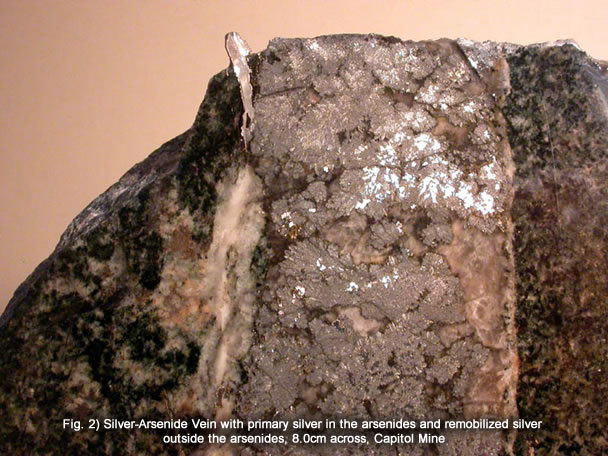
Origin and Processes of Mineralization
Many of the various models on the origin of the silver veins are based on the occurrence and distribution of the silver veins. All of the deposits occur at or near the Archean-Huronian uncomformity. They are spatially associated with Nipissing diabase either within or within 600 feet of its upper and lower contacts. Many of the mineralized veins occur on the upward projection of Archean supracrustal rocks and many are found near volcanogenic base metal sulfide deposits in the Archean basement (Andrews et al., 1986).
The origin of the silver-bearing veins and their metal sources has been hotly debated since their discovery in 1903. In spite of the work done, including an entire volume of the Canadian Mineralogist (“The Silver-Arsenide Deposits of the Cobalt-Gowganda Region, Ontario”) and papers included in the Canadian Journal of Earth Sciences (vol. 23, No. 10, 1988, “Silver Vein Deposits”) the source, timing and processes of silver-arsenide vein mineralization remain unresolved.

Based on the above observations virtually every rock type that occurs in the area has been proposed as a possible source of the metals and gangue vein material. These include;
1. Archean metasedimentary beds with minor contributions from metavolcanics (Boyle and Dass, 1971; Smyk and Watkinson, 1990).
2. Archean carbonaceous, pyritic tuffs (Watkinson, 1986).
3. Base metal sulfide mounds in the Archean metavolcanics (Goodz et al., 1986).
4. Huronian sediments (Kerrich et al., 1986) and Cobalt Group sediments in particular, the Coleman member (Appleyard, 1980; Innes and Colvine, 1979).
5. Nipissing diabase (Jambor, 1971d).
6. The same magma chamber as the Nipissing diabase (Sampson and Hriskevich, 1957).
7. A separate deep rooted parental magma source (Miller, 1913; Bastin, 1939; Moore 1955).
Although it is beyond the scope of this article to present all the models that have been proposed, interested readers should refer to the references for further details, it is interesting to note that one of the earliest, most persistent and simplest models is that related to the intrusions of Nipissing diabase. In this model the diabase acted as a heat source which initiated a long term hydrothermal convection system resulting in the leaching of metals from the host rocks and their deposition in favorable faults, shear zones and zones of dilatancy. There are several lines of evidence that dispute this model; the observation that veins can cut completely across intrusions of diabase including the contact metamorphic “chlorite spots” (Andrews et al., 1986). Nipissing diabase intrusions are widely distributed throughout the Southern Province but the veins are restricted to the northern and eastern boundary of the Cobalt Embayment. Also the silver-arsenide veins at Cobalt are not unique, they are similar to other epigenetic, hydrothermal five-element (Co-Ni-As-Ag-Bi) vein assemblages found in a number of localities and the spatial association evident at Cobalt with diabase is not typical (Bastin, 1939).
Europeans have been exploring and engaged in trade, in this part of Canada, for several hundred years. In fact, the Ottawa River, Lake Temiskaming and Montreal River, all of which are in close proximity to the silver deposits, were travelled for centuries by aboriginals and Europeans with no in-situ veins ever being discovered, as far as we know. This is surprising since, for centuries, regular canoe, boat and steamer transport travelled within one km of some of the silver veins!

Recent research on silver artifacts from aboriginal cultures (Spencer and Fryer, 1990) indicates that aboriginal people DID know about silver from the Cobalt area to some extent. Trace element analyses show that silver in some artifacts ( pan pipes, buttons and jewelry) did originate from the Cobalt area and were transported/traded as far from Cobalt as Mississippi, USA. Although there were no known pre-European mine workings in the Cobalt area, it is possible that such workings were destroyed or that silver from the artifacts was gleaned from glacial drift or river washed deposits.
The French had heard rumours of silver in the region since the early days of colonization in North America. Jacques Cartier records some of these rumours in the notes from his voyage of 1535-36AD, but apparently never followed up.
Sieur de Troyes was told about an argentiferous galena vein on the eastern shore of Lake Temiskaming and investigated it on his way to James Bay in 1686. (Smith, 1986). The vein was mostly just galena and was not exploited, to any great extent, at the time. The vein did eventually become the Wright Mine and a few tons of mineralization were mined in 1850 for the lead content.
The modern discovery of silver veins at “Long Lake” coincided with the construction of the railway from North Bay to New Liskeard, to serve the growing agricultural community, in the “clay belt” north of New Liskeard. People had been settling the area north of Haileybury and New Liskeard for many years prior to the discoveries at “Long Lake”. Workers encountered heavy, metallic minerals in the vicinity of the right of way and eventually staked claims.
The most famous of these discoveries was by Fred LaRose, a blacksmith working on the railway. As legend has it, during the summer of 1903, Fred threw a hammer at a pesky fox that lingered near his forge. Apparently the hammer glanced off a rock outcrop and Fred noticed that the rock had a distinct metallic gleam to it where the hammer had hit. He collected some samples and took them with him to Haileybury on an excursion to the Matabanick Hotel, one of the favourite watering holes of people in the Haileybury area. LaRose thought that the samples could be copper rich due to the coppery colour and green oxidation stains. He gave them to the proprietor of the Matabanick, Mr. Arthur Ferland, who, in turn, showed them to T.W. Gibson, Director of the Ontario Geological Survey, who also happened to be frequenting the Matabanick Hotel. Gibson recognized that the samples contained nickel and then forwarded the samples to Dr. Willet Green Miller, the first Provincial Geologist of Ontario, accompanied by a letter which stated:
"I am enclosing herewith a fragment of a larger sample of what I take to be kupfer-nickel found along the line of the Temiskaming and Northern Ontario Railway. The locality of the deposit is in the unsurveyed territory immediately south of the Township of Bucke. I have not learned anything as to the extent of the discovery, but if the deposit is of any considerable size, it will be a valuable one on account of the high percentage of nickel which this mineral contains. I think it will almost be worth your while to pay a visit to the locality of the discovery before navigation closes. I am under the impression that the find was made while making the cutting for the railway. Mr. Ferland, of Haileybury, showed me a sample of the mineral when I was there, but he did not appear to recognize it or know its value, deeming it to be a compound of copper. It would be remarkable should our nickel deposits turn out to have a wider range than hitherto been supposed and especially if the new outcrop should be a large one containing ore of so high a grade."
Gibson was theorizing, in this note, that perhaps the nickel deposits of Sudbury, a couple of hundred km to the south-west, possibly extended up to the Lake Temiskaming area! He didn’t notice the silver in the sample!
Miller recognized that the samples were nickel-rich but also were laced with native silver! This caused him to make a visit to the Long Lake area in November of 1903, just before the snow began to fly. He examined the few veins that had been discovered and collected samples rich with cobalt, nickel and silver that he took back to Toronto.
The first official mining claim at Long Lake was staked by two partners, J.H. McKinley and E.F. Darragh, on August 13, 1903. McKinley and Darragh were contractors to the Railway, charged with supplying timber and ties for construction. They had noticed heavy, metallic, relatively soft minerals around the railway right-of-way and staked a claim and sent samples off for analyses. The first analysis results that came back showed only that the samples were rich in bismuth. However, the second samples showed very high silver content, over 4000 ounces of silver per ton (Smith, 1986)!
Willet G. Miller realized that the samples he had carried back to Toronto with him, to look at over the winter, were amazing and represented some potentially very rich deposits. He returned to Long Lake in the spring to further inspect and learn about the veins. He wrote in his 1904 report:
"Vein No.4, although having the smallest width of the four is, in many respects, the most interesting of the group. Here a perpendicular bare cliff of rock, 60 or 70 feet high faces west. The vein whose width averages not more than 8 inches, cuts this face at right angles, and has an almost vertical dip. The vein is weathered away leaving a crack in the face of the cliff 2 feet, in some places 4 or 5 feet in depth. When I saw it first, it had not been disturbed. Thin leaves of silver up to 2 inches in diameter, were lying on the ledges, and the decomposed vein matter was cemented together by the metal, like fungus in rotten wood. It was a vein such as one reads about in textbooks, but which is rarely seen, being so clearly defined and so rich in contents. It was found impossible to get a fresh sample of the ore with the prospecting pick, the vein being so much decomposed."
During 1904, Dr. Miller decided that “Long Lake Construction Camp” was not a good enough name for this exciting, burgeoning place and he put up a post at location of the future railway station with a sign on it announcing “Cobalt Station, T and N.O. Railway”. The name “Cobalt” stuck and it has been called that ever since.
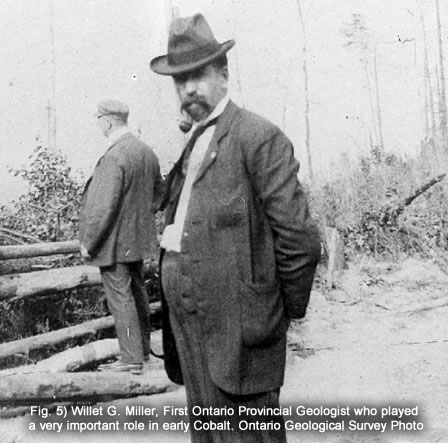
A few prospectors travelled to Cobalt in the spring of 1904. One was William Trethewey who had learned of McKinley and Darragh’s second set of assays and decided to visit Cobalt to see if he could locate a source of these rich silver samples. Here is test of his description of the state of Cobalt, at the time (Davis, 1910):
"While metallic silver had never amounted to much in Ontario, I was determined to visit Cobalt as soon as the snow was out. I came to Toronto, saw the department, got my license and equipped myself for prospecting. I left Toronto on May 6, 1904. At that time, one had to go to North Bay by the Grand Trunk, then on the CPR to Mattawa and by the short line to Temiskaming. From Temiskaming one had to get to Haileybury by Lumsden steamers. From Haileybury we had to walk over a muddy trail about five miles to the new camp. No one at that time appeared to be very much impressed. Even the fellows who made the discoveries not being at all excited, although the silver was looking them in the face. My idea was to buy something in the camp but I discovered that no one was prepared to sell. I went back to Haileybury and hired a man there and came right back, pitched camp on what is now the O'Brien property and started to prospect. Alec Longwell, who was up there for Mr. Leonard, shared my tent with me. I was prospecting just two days. On the second day I went to Pickerel Lake, where Longwell thought there was something good, but found nothing, and came back to camp at 1 o'clock. About 4 o'clock I thought I would finish up the day, and I struck out in a northerly direction, to a section to which no one had paid any attention at all. The impression at that time was that the valley along which the T. and N.O. ran, divided the mineral area from that which contained no silver, as all the discoveries so far had been made on the east side of the divide.
I walked almost straight to the old Trethewey mine. I passed over several ridges until I struck one where the rock looked good and I followed it south. As I walked along it I could see where the other fellows had torn away the moss. I came to a bluff where the point ran down into a swamp. I had to wade into the water to get round its western face. I could not see the face of the cliff until I had got out about twenty feet, when I saw a black streak on its face and I knew it was a silver vein. My first anxiety was to see if anyone had been there before me, but after a careful examination I concluded that it was a virgin discovery. I had no axe with me, and there were fellows down at camp who would have made a wild rush up there if they had known, and I might have lost my mine. So I hid it as well as I could by throwing sticks and moss over the rock where I had chipped it, and came down to my tent and quietly had my tea. I did not know how to get away from the camp without the others following me, so I said to my man, "Give me my axe, I am going to chop a tree down.”
I started out with my axe on my shoulder slowly enough until I got out of sight of the camp, and then I only hit the ground at the high places, I squared a post, put the number of my license and my name on it and planted it firmly over the discovery. And I made a witness tree. Then I started along the bluff a little farther and discovered the Coniagas mine (Figure 3). I knew by the indications that there was a vein but it was dark and I was afraid of getting caught in the woods. I saw Professor Miller that night and told him that I had made a find and asked him to say nothing. He and his assistant, Cyril Knight, visited the property with me next morning and we examined it carefully to see if there were any signs of prior discovery. But there was nothing."
Trethewey wasted no time to mine one of the veins and excavated an open cut 50 feet long by 25 feet deep, from which he removed 340,000 troy ounces of silver. The vein was no more than eight inches thick at any point! The veins discovered by Trethewey turned out to be very rich and eventually produced over 40 million troy ounces of silver. When Trethewey’s first shipment of silver, containing many slabs of native silver metal, reached the south, people became very excited and a rush to the Cobalt area resulted with claims established all over the area.
Mining, in Cobalt started off slowly with only 158 tons of ore being shipped in 1904 (Figure 5). In 1905, however 2,144 tons of hand-picked ore were shipped containing 2,451,356 ounces of silver. The grade averaged over 1,143 troy ounces of silver per ton (Miller, 1913).
A number of other veins were found, claims staked and by 1905, there were 16 mines in operation (Petruk et al, 1971), in the vicinity of Cobalt. In the subsequent few years, exploration expanded outward and rich silver veins and other prospects were found in South Lorrain Township, Casey Township, Miller Lake area, Gowganda Lake area and Elk Lake. Silver Production reached its peak in 1911 when 31,000,000 ounce of silver were shipped. Production continued at a high level until the mid –late twenties when the price of silver collapsed. After that period, the various claims were leased out to small operators who continued to mine small veins and “rob pillars” to make a living. There have been several times when the prices of silver and cobalt have risen enough for mines to be open for periods of time and a few operated on a continuous basis until the mid 1980’s when the last two mines, the Silverfields and Agnico Eagle finally closed.
One of the unique things about the Cobalt mining camp is that the mineral wealth was so easily accessible. Veins consisting largely of native silver, argentite and other silver minerals were mineable right at surface. Although, the country rock was very hard, the veins were soft and weathered. A man needed nothing more than a pick and shovel to get started. A hard working man could generate considerable wealth very quickly if he was lucky enough to find a vein. Surface mining is easy, compared to underground mining and mining down to a depth of 50 feet or so by open cut required no more than drill steel, dynamite, wheel barrow, shovels, plus a good measure of muscle. W. Trethewey took $250,000 (1904 dollars!) of silver out of a cut 50 feet long and 25 feet deep in that manner (Smith, 1986). The vein that he mined was eight inches across at its widest point.
Over the years, more than one hundred separate mines and prospects were active in the Cobalt area. These mines spawned the miners, mine managers and prospectors that were to move to the other mining camps yet to be discovered throughout northern of Canada. This is why Cobalt is called "The birthplace of Canadian hardrock mining."

Of course, such a sudden discovery of wealth cannot take place without a "boom town" occurring and Cobalt was no exception. At one stage, Cobalt had a population of twelve thousand. There were a dozen hotels, a hospital, four banks, nine restaurants, a National Hockey Association team (forerunner of the National Hockey League), even an opera house (Smith, 1986) and a mill and shaft in the downtown. It was remarkable that such facilities existed only a few years after the area had been a relatively remote wilderness area with just a few prospector tents.
Exploration spread out in all directions from Cobalt and similar, significant silver discoveries were made in subsequent years in other areas close by including Gowganda Lake, Casey Township, Elk Lake and South Lorraine Township.
The wealth and excitement generated by the Cobalt discoveries fed the enthusiasm and wallets of mining companies and prospectors and enabled them to discover a number of other mining areas, mostly gold, as they spread north from Cobalt. Other mining camps that were directly related to the flow of prospectors passing through, and the money generated from Cobalt were Larder Lake (1906), the Timmins area (1909), Kirkland Lake (1911) and Matachewan (1916) and Noranda (1920).
The minerals in the ore veins at Cobalt and their textures are fascinating. The elemental make-up of the mineralizing agents and the complex nature of deposition have resulted in a unique and beautiful assemblage made up of, primarily, the "silver-colored" sulfides and arsenides such as skutterudite, safflorite, gersdorffite, cobaltite, arsenopyrite, glaucodot, rammelsbergite, pararammelsbergite, allargentum and elements such as bismuth and silver. Since these minerals have similar coloration and occur in intimate association, identification of individual minerals in a sample, by eye is usually very difficult without the aid of carefully executed chemical tests, electron dispersion spectroscopy (EDS) microprobe analyses or X-Ray diffraction (XRD) analyses.
NOTE* It is also worth noting that the predominate carbonate in the veins at Cobalt is, in fact, dolomite with calcite occurring as a less voluminous late stage vein filling. In the Gowganda area, however, the predominate carbonate in the veins is calcite. (Pers. Comm. R. Mielke, 2015)
In addition to the arsenides and sulfides, silver minerals such as acanthite (pseudomorphs of acanthite after argentite) proustite, stephanite and silver, are all are found in magnificent specimens.
The Cobalt-Gowganda area includes type localities for several minerals: allargentum, burgessite, chapmanite, clinosafflorite, ferrisymplesite, langisite, laroseite, mckinstryite and pararammelsbergite.
The crystallization of minerals into the host rocks appears to have occurred during emplacement of Co-Ni-Fe-Ag-Sb-As-S rich solutions, with the chemical make-up of the solutions varying somewhat with each phase, probably due to the depletion of certain elements in a progressively cooling system. Generally, the silver crystallized first with arsenides and sulfides later, with silver (with significant antimony content) deposited throughout the entire depositional period. It appears that some silver and antimony was remobilized during the latter phase of the deposition and re-precipitated as silver (no antimony) and silver antimonides. Gangue minerals, mostly carbonates, chlorite and quartz appear to be contemporaneously deposited with the ore minerals with a generation of quartz and chlorite often first. Oxidation of vein materials occurred in the upper portions of the orebodies but significant secondary enrichment was not common.
The complex emplacement of the ore minerals resulted in an extremely layered texture in the ores. The various minerals were deposited as botryoidal, dendritic and branching aggregates which, in cross-section, appear as multilayered "rosettes" with earlier minerals at the centre and later minerals in the outer layers. The highest grade ores have silver at the core of the rosettes and in association with the arsenide suite of minerals (Petruk, 1971b). Often, the cores are empty with silver having migrated to fractures in the veins and wall-rock. Pseudomorphs of arsenide minerals after silver crystals are common. The combinations are very interesting and attractive and have drawn mineralogists to examine their make-up since their initial discovery.
The ore veins occur in “groups” that have basically similar composition and characteristics within a nest. The chemical make-up of the groups varies to some degree although the general characteristics remain similar.
The following is a listing and discussion of the minerals occurring in the Cobalt-Gowganda ores with emphasis on the species that occur in significant well crystallized specimens or that are directly associated with the ores. Unless noted, specimens are from or have been from the David K. Joyce collection.
The most common silver sulfide at Cobalt formed at a high temperature, during vein emplacement, as isometric crystals of argentite. As these crystals cooled their atomic arrangement inverted to the monoclinic form of silver sulfide known as acanthite. Many collectors still refer to this material as argentite, but in strict mineralogical terms, most specimens of this mineral are pseudomorphs of acanthite after argentite. Such a change in crystal unit cells takes places at the atomic level and the outward shapes of the crystals maintain their isometric symmetry. In the following description we refer to these in terms of isometric forms.
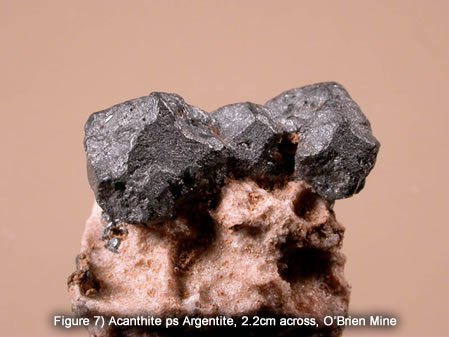
Acanthite, AgS2:
Acanthite, referred to at the time as argentite, was one of the first minerals found at Cobalt. Chunks of the black silver sulfide were found admixed with silver in the upper levels of silver veins and on surface around the vein outcrops.
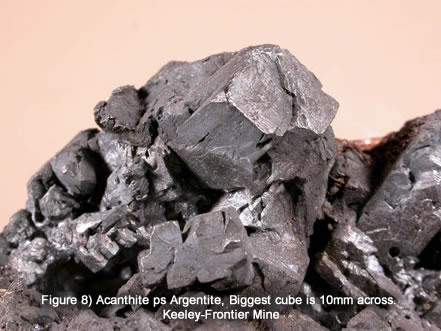
The dominant forms of acanthite are cube, cube-octahedral and octahedron, although complex intergrowths of these and other forms are not uncommon. Interpenetration twins are also noted especially on M16330 in the ROM collection which is associated with well formed stephanite crystals. Although a few crystals are sharp and lustrous, most are dull and rather crude. However, exceptionally large masses of crystals have been recorded and some very large individual crystals are known. Acanthite also occurs as solid vein-like masses, from 30mm thick. There are superb octahedra up to 12mm on an edge in pink calcite from South Lorrain and on another specimen from the same locality 3mm cubes were noted with tiny radiating groups of acanthite needles perched along their edges. It is almost certain that these are secondary growths that formed in the storage cabinet and take the form of primary acanthite. Some of the crystals are hollow, hopper-like in habit, the cube faces may show striations parallel to the cube edges, which might be due to the growth of the tetrahexahedron on the cube. Wire silver is frequently seen growing from the faces of acanthite crystals.
Although acanthite is known to occur at many of the mines, the best crystal specimens that have survived are from Castle-Trethewey, Cobalt Lake, O'Brien, Keeley-Frontier, Langis, Silver Miller, Silver Cliff, and Silver Queen mines.
Alabandite Extremely rare. It has only been found at the Helens-Eplett Mine. It is believed to be from a massive sulphide ore body (copper-zinc) found in the Keewatin volcanics underground in 1988. It is not associated with the arsenide-silver veins. Occurs in rhodonite as black masses up to 2cm across and is associated with sphalerite, chalcopyrite, tetrahedrite,galena, pyrite, and johannsenite (Pers. Comm. R. Mielke, 2015).
Albite Albite is commonly in crystals to 2cm in late calcite-quartz veins that are not related to the silver or Co-Ni-As veins. (Pers. Comm R. Mielke, 2015)
Aikinite canoccur as solid veinlets to 8mm thick in the Cobalt area. (See fig. 30) Crystals have not been noted.
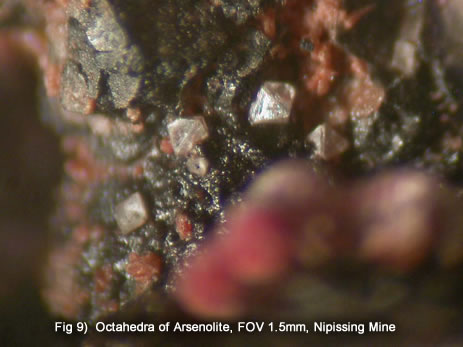
Allargentum Masses of allargentum have been found and often were erroneously determined to be dyscrasite (Petruk, 1971e), due to their composition. It is difficult to differentiate allargentum from silver in Cobalt ores. They both occur as veins and veinlets cutting other minerals in the veins. As well, allargentum occurs as lamellae in silver and can, usually, only be seen by slicing, polishing and etching polished surfaces with acid. These lamellae can also, occasionally, be seen on fracture surfaces of silver without cutting, polishing and acid etching. (personal communication Reiner Mielke, 2009). (See Figs 31,32,33)
Alloclasite This mineral has been found as microscopic phases with glaucodot and as small masses with safflorite (Petruk et al., 1971c). It is very difficult to identify visually unless it is in crystals. It needs x-ray diffraction (XRD) in combination with chemical analysis to differentiate it from other arsenides. (Pers. Comm. R. Mielke, 2015)
Anglesite Micro crystals have been noted at the Lawson mine in association with the mimetite and cerussite. (Pers. Comm, Reiner Mielke)
Annabergite Usually found as a powdery greenish crusts on Ni arsenides that formed post mining. Occasionally found as clay like masses to 20cm resulting from the post mining weathering of fragments of rammelsbergite and nickeline. The colour depends on the cobalt content and can vary from greenish to white to pinkish.
It also occurs as very fine grained solid masses and veins in the upper oxidized portions of arsenide veins and is associated with acanthite and silver. (Pers. Comm. R. Mielke) Very rarely is it found as crystals to 1mm in vugs in massive pararammelsbergite associated with tiny botryoids of arseniosiderite. The annabergite crystals vary in colour from colourless to pale green. (Pers. Comm. R. Meilke) (See Figs 34,35,36)
Aragonite Found as tiny white crystals in near-surface mineralization (Pers. Comm R. Mielke).
Arseniosiderite Very rare. Has only been found as golden-brown, micro botryoids on annabergite crystals in vugs in massive pararammelsbergite at the Curry Mine near Silver Centre. This is the only known occurrence in Canada.
(Pers. Comm. R. Mielke)
Arsenolite One would expect to find more secondary arsenic minerals in the Cobalt Camp but, due to efficient glaciation, most were destroyed during the last ice age. On occasion, tiny octahedral crystals of arsenolite can be seen amongst other secondary minerals such as erythrite. Note that there is also a “cabinet growth” of arsenolite that can form on arsenide mineralization and that these tiny perfect octahedral are post mining growth. (see also Fig. 37)
Arsenopyrite A very common constituent of Cobalt area ores, this mineral most often occurs as millimeter sized crystals and druses of crystals with individuals in the 2mm size range but crystals can be up to 10mm across. It is associated with all of the common ore minerals at Cobalt.
Bismuth This native element does not occur as crystals in Cobalt area ores but does commonly occur as rich, coarsely crystallized, late stage vein fillings. Specimens from Cobalt are usually vein sections consisting of pure, brilliant cleavable masses with individual cleavages and vein sections up to 6.0cm across. (See Figs 37, 38)
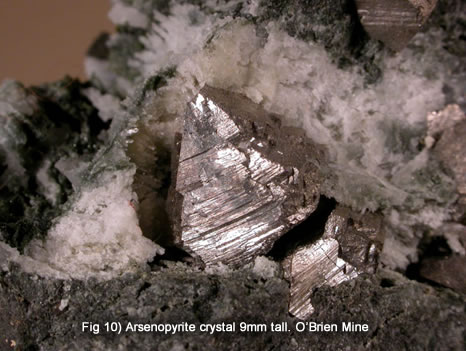
Axinite-(Fe) Axinite-(Fe) occurs on one specimen at the ROM as course 10mm crystals on specimen M29427. Recently, very good crystals have been found at the Silver Miller Mine by R. Mielke.
Bismuthinite A common mineral usually found in small amounts associated with bismuth. The most common form is thin needle-like crystals in vugs in calcite and inclusions in calcite. Sometimes in sufficient amounts to make the calcite look black. Needles can be up to 3cm long but are usually less than 1cm. Also found in compact fine grained masses and rarely as fibrous looking veins up to 1cm wide. The colour is normally black but has been found tarnished blue (Pers. Comm. R. Mielke, 2016). The most common associated minerals are calcite, bismuth, and quartz. (See Figs. 12 and 40)
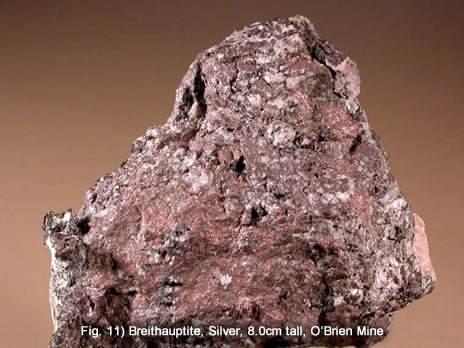
Bismutite Rare but may be more common as it is likely not to be recognized. It is an alteration product of native bismuth, and has been found as thin grey glassy coatings up to 1 mm thick on native bismuth. (Pers. Comm. R. Mielke)
Bornite This mineral is always massive in Cobalt area ores and although not particularly common, it occurs in many of the mines in small amounts. Often associated with leafy silver.

Breithauptite This mineral is relatively common in the veins at Cobalt and was one of the first minerals noted during the initial discovery. At the time, it was mistaken for a copper mineral, probably because of its peculiar pink-red metallic color. Breithauptite occurs in the veins at Cobalt as masses, sometimes filling the entire vein or replacing other arsenides/sulfides and silver. It has been found in microscopic crystals. (See Figs 41, 42)
Burgessite A new mineral recently discovered from Cobalt (Sejkora et al., 2009). It looks very similar to erythrite and some erythrite in collections may, in fact, be burgessite.
Calcite Calcite is one of the main constituents of the ore veins and sub-veins in the country rock. Small crystals lining cavities in the veins are common but good, larger calcite crystals are not common. Very nice lavender-colored calcite crystals up to 45mm were recovered from the Cross Lake mine.
Cerussite Very rarely found in oxidized vein material. Has been found in excellent micro crystals at the Lawson Mine. (Per. Comm. R. Mielke) (See Fig. 43)
Chabazite Chabazite has been seen on only one specimen (ROM collection M14544) in colorless, rhombohedral crystals up to 3mm associated with colorless stilbite. The location is given as the west-side of Cross Lake.
Chalcopyrite This mineral occurs as masses and veinlets in the ores of the Cobalt/Gowganda area mostly as massive patches or vein fillings but just occasionally as tiny crystals. It often occurs with bornite and carbonates. When in the presence of significant silver, often tarnishes a bright blue (Pers. Comm, R. Mielke, 2015).
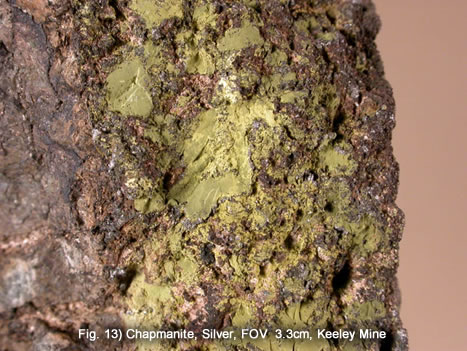
Chapmanite The Keeley mine in the South Lorraine area near Cobalt is the type locality for chapmanite. It was named for Professor E.J. Chapman of the University of Toronto. This unusual mineral occurs as vein fillings of green, earthy to porcelaineous, massive mineral up to 50mm, often laced heavily with native silver. No crystals have been observed.
Clinosafflorite The Cobalt area is the type locality for this monoclinic polymorph of safflorite (Radcliffe and Berry, 1971). It occurs finely intermixed with skutterudite (Petruk, W. et al, 1971d) and has been noted only in polished section.
Chlorargyrite Rarely seen in the Cobalt Mining Camp but it has been noted from the Nipissing mine as small patches in gossan (ROM samples M18902 and M18898).
Cobaltite Common and ubiquitous in small amounts as grains mixed with other silver-coloured arsenides. Rarely as crystals forming octahedra and modified cubes. The cubes can only be distinguished from skutterudite with chemical tests or XRD. Chemical tests, alone, will not work if trying to differentiate cobaltite from alloclasite, and glaucodot since the chemistry of cobaltite is too similar. A number of specimens in the ROM collection from the Columbus mine, most notably M8681, have very sharp, silvery, cube-octahedral crystals measuring up to 8mm across.
Cosalite Occurs as masses of tightly packed needles to 5mm at the Columbus mine, such as ROM sample M9700.
Dolomite Dolomite is a common vein constituent at various stages of vein development. Only small crystals have been noted.
Dyscrasite Although originally reported as common from Cobalt area ores, dyscrasite is actually rare in the Cobalt/Gowganda ores. Most specimens originally thought to be dyscrasite turned out to be intergrowths of allargentum and silver (Petruk et al., 1970).
Erythrite Erythrite is present in any area of the camp that contained cobalt bearing minerals and that has undergone oxidation, both in the veins and in the country rock surrounding the veins. In fact "Cobalt Bloom" was the most common indicator that prospectors used to detect the presence of cobalt and, possibly, silver bearing veins. Erythrite can be seen in/on most of the old workings in the Cobalt camp, even today. While most of it is powdery and often mixed with other oxidation minerals, some attractive botryoidal coatings or hemispherical aggregates composed of fine, sub-millimetre, needle-like crystals are encountered. It should be noted that erythrite can range from deep-pink in colour to grey or white. (Pers Comm, R. Mielke, 2015) (See Figs 44, 45, 46)
Ferrisymplesite The Hudson Bay mine is the type locality for this rare mineral. There are specimens from that mine and, as well, the O'Brien and Cobalt Lode mines in the ROM collection. The mineral occurs as amber brown, resinous particles and botryoidal masses with erythrite or other oxide minerals. It is sometimes found as white botryoids and crusts of crude micro crystals on honey-coloured scorodite in vugs in weathered loellingite vein material.(Pers. Comm. R. Mielke, 2015)
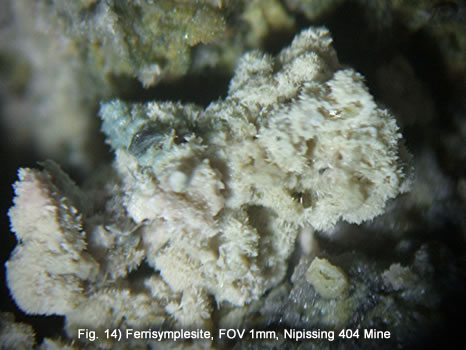
(Fluor)Apatite Apatite as pale-pink, tubular-shaped crystals up to 3mm by 2mm associated with cobaltite crystals from the Columbus mine have been noted on at least one ROM specimen, M53923. Noted at the Castle Mine, Gowganda in crystals to 18mm in length and the Keeley Frontier in crystals to 24mm (Pers. Comm. R. Mielke, 2015). (See Figs 47,48)
Freislebenite This mineral was found in ROM specimen M21270 as a minute veinlet in a skutterudite grain (Petruk, 1971c). It is very rare at Cobalt.
Gersdorffite Although it is represented in the ROM collection in only two specimens, as crystals to 7mm embedded in other arsenides, it could be much more widespread than that as a phase in layered cobalt-nickel arsenides.

Galena This mineral is not common but is found at some localities in the Cobalt-Gowganda area. Most specimens consist of massive or disseminated galena with calcite, silver, tetrahedrite and other ore minerals. A vein of solid galena was found in Gillies Township, just south of Cobalt but it is not known if it was related to the Cobalt silver veins.
Glaucodot There is a specimen of glaucodot in the collection of the ROM. It is a vein section consisting largely of 7mm coarse crystals embedded in other arsenides. Masses to 30mm have been found associated with safflorite (Pers. Comm. R. Mielke). Most often, glaucodot occurs in masses that can only be identified by chemical analysis. Visual identification is not possible. (See Fig. 49)
Goethite Goethite – Found uncommonly as micro crystals associated with late calcite veins which are associated with silver secondary minerals at the Nova Scotia Mine and bismuthinite, bismuth and quartz at the Keeley-Frontier Mine. They occur as bright yellow to golden needles and clusters up to 0.5mm in vugs. (See Fig. 50) At the Keeley-Frontier Mine, a rinkite group mineral is also found as crystals to 0.1mm in the same environment which looks identical to the goethite but can only be distinguished with EDS. (Pers. Comm. R. Mielke, 2015)
Guérinite A rare post mining mineral which forms white pearly crystal clusters up to 0.5mm on and with acicular crystals of picropharmacolite crystals on weathered dolomite. May be associated with erythrite (Pers. Comm. R. Mielke, 2015).
Johannsenite Extremely rare. It has only been found at the Helens-Eplett Mine. (Pers. Comm. R. Mielke) It is believed to be from a massive sulphide ore body (copper-zinc) found in the Keewatin volcanics underground in 1988. It is not associated with the arsenide-silver veins. Occurs as fibrous pale grey to brownish- grey masses up to 2cm across in rhodonite. Associated with sphalerite, chalcopyrite, tetrahedrite, galena, pyrite, and alabandite. (See Fig. 51)
Kainosite-Y Is very rare and has only been found at the Castle mine where it occurs in snow white granular calcite on Co-arsenides. It is a reddish brown and can be found in single crystals and clusters of radiating crystals ( rare) up to 20mm long. (Pers Comm. R. Mielke) (See Fig. 52)
Langisite The Langis mine was the type locality for this very rare mineral. It occurs in safflorite as veinlets, grains and lamellae with a bismuth and cobalt sulfides (Petruk et al., 1971d). There are two specimens (holotype) in the ROM collection M28883 and M28884.
Larosite Larosite was found in a sample at the Geological Survey of Canada. It consisted of acicular crystals cutting across stromeyerite, chalcocite and polybasite. The type locality of this mineral is the Foster mine.
Laumontite Only one specimen of this mineral, ROM M19992, from the Cobalt-Gowganda area is in the ROM collection. It consists of 2mm crystals in oxidized ore from Coleman Township.
Löllingite This mineral occurs in many mines of the area as massive, feathery and colloform masses comprising entire veinlets. Dendritic growths composed of löllingite crystals have been encounteredat the Rustex (Hudson Bay) mine and typical specimens have been etched out of calcite. (See Figs. 55, 56)
Magnetite Common as small grains in diabase but also occurs as large masses sometimes in crystals to 1cm in the silver veins. (Pers Comm. R. Mielke, 2015) I hadn’t noticed this until recently when one of my Cobalt friends showed me how a magnet could be strongly attracted to high grade ore with a black mineral (magnetite) in it.
Matildite Occurs as microscopic lamellae and irregular grains in galena in several specimens from the Foster and O'Brien mines. No discrete crystals have been found.
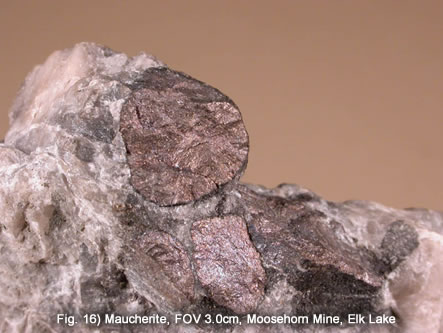
Maucherite It is interesting to note that this mineral was originally described as "Temiskamite" from the Moose Horn mine by Walker in 1914 but soon after was found to be the same mineral as Grunling had described one year earlier as maucherite and so the name maucherite took precedence. The more interesting specimens consist of rounded, pea-sized, nodular aggregates from the Moose Horn mine (Figure 16) but it also has been reported from the Langis and Colroy mines. It occurs often with nickeline and other Co-Ni arsenides (Petruk et al., 1971d). Maucherite also occurred at Peterson Lake Mine in an almost solid vein of maucherite 3 inches thick with pyrargyrite and a grey fine grained quartz (Pers Comm. R. Mielke).
Mckinstryite The Foster mine is the type locality for this very rare mineral. It was found in a sample by Skinner et al.1966, occurring with chalcopyrite, stromeyerite, silver and arsenopyrite.
Millerite A rare mineral in the Cobalt-Gowganda area. It occurs in a sample from the Miller Lake O'Brien mine ROM specimen M47001 as 3-4mm crystals embedded in massive arsenides.
Mimetite occurs in one specimen in the ROM collection as a coating on corroded galena. It has been noted at the Lawson Mine as sharp micro crystals in association with micro cerussite and anglesite crystals on corroded galena (Pers. Comm. R. Mielke) (See Fig. 57)
Nickeline This mineral is very common in the Cobalt-Gowganda area and was one of the chief economic minerals of nickel in the concentrates. Although it is very common, crystals are not. It is most commonly found as massive vein sections up to 9 inches and as lobular aggregates, often with rich native silver and with many of the other cobalt-nickel arsenides. R. Mielke reports finding crude crystals to 7mm in length. Some very sharp, 1-2mm, hexagonal-prismatic crystals have been found but seem to be pseudomorphs of various other arsenides after nickeline. (See Figs. 58-65)
Nickelskutterudite This mineral is not known to occur in the Cobalt Gowganda area, despite being reported over the years. It has been reported at the Hudson Bay mine (Rustex mine) near Gowganda where it purportedly occurred in superb crystals to 10mm. Analyses of these crystals showed the mineral to be skutterudite.
Orschallite Very rare. It has so far only been found at the Nipissing 404 on weathered mineralizations in dumps. It is associated with abundant picropharmacolite, pharmacolite, erythrite, bismuth, and cobalt arsenides on weathered dolomite. Forms white to clear pseudo cubic crystals up to 1mm across (Pers Comm. R. Mielke). (See Fig. 54)
Pararammelsbergite The Moose Horn, Hudson Bay and Keeley mines are listed as type localities for this fairly common mineral from the Cobalt-Gowganda ores. Is fairly common in the Ni-arsenide assemblages and is usually associated with nickeline but can also occur as large masses of anhedral crystals (up to 1mm long which appear tabular). The largest crystals are found in nickeline and can be up to 2cm long. The crystals in nickeline are thin tabular crystals which sometimes show terminations if they protrude into vugs. Some of these crystals can be very complex. The pararammelsbegite in massive samples can be identified by its excellent cleavage which imparts a sparkle when you turn the sample in the sun. None of the other silvery arsenides assemblage show this sparkle in massive samples. Also samples that contain pararammelsbegite will weather green as will nickeline and rammelsbergite (Pers. Comm. R. Mielke, 2015). (See Fig. 53)
Pearceite Occurs as micro crystals in a cavity in ore on ROM specimen M29542 from the Silver Miller mine.
Picropharmacolite A common post-mining mineral which forms white crusts and rarely small stalactites ( to 5cm long) on buried fragments of rock. Sometimes also found as acicular crystals to 1cm long and botryoids of needles on the surfaces of rock fragments. Associated minerals are erythrite, and rarely guérinite.
Polybasite Polybasite, in small crystals, is often found in the oxidized portions of Cobalt area veins. (See Fig. 66) However one notable specimen from the Keeley mine, in the collection of the ROM, has crystals up to 10mm across.
Proustite This is the most common “ruby silver” mineral that occurs in the Cobalt mining camp. It occurs in excellent prismatic and scalenohedral crystals to 20mm in oxidized portions of the silver veins, in association with various arsenides, calcite and xanthoconite. The best examples occurred at the Keeley mine and are preserved as beautiful specimens at the ROM. Well crystallized proustite also occurred at the O’Brien, Nipissing and Christopher mines. It is also found in veinlets and blebs in ores at many mines. (See Fig. 67)
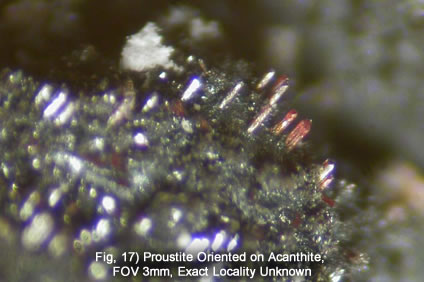
Pyrargyrite Pyrargyrite is not common in the Cobalt-Gowganda deposits as crystals. It seems to occur most commonly as massive veinlets or patches in ore as a replacement of silver and allargentum (Petruk et al., 1971c) or derived from silver. It is associated with acanthite, silver and tetrahedrite. Most “ruby silver”, at Cobalt, is proustite.
Pyrostilpnite This mineral is not common at Cobalt but has been found in good specimens. One, in particular (Fig. 18), illustrated, shows pyrostilpnite that has formed as an almost dendritic crystal structure in a seam in silver rich vein material.
Pyrrhotite This mineral occurs fairly commonly in the veins, usually outside the areas mineralized with arsenides (Petruk et al., 1971c). It occurs as minute to 0.10 inch platy, hexagonal crystals in cavities and embedded in many other minerals.
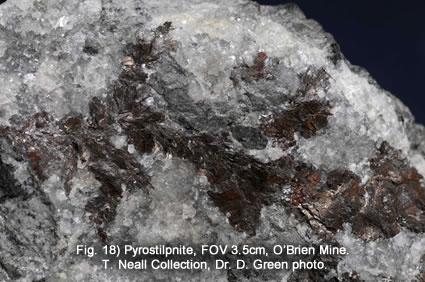
Quartz Quartz usually occurs as rounded prismatic crystals embedded in carbonate gangue and arsenides, not as good crystal specimens.
Rammelsbergite This mineral is fairly common in the Cobalt-Gowganda ores. It occurs as massive sections in veins and, in cross section, bulbous aggregates in carbonate veins. It is a common constituent of the ores intergrown with other arsenides and as a component of arsenide rosettes as radiating prismatic layers (Petruk et al., 1971d).
Rhodonite Extremely rare. It has only been found at the Helens-Eplett Mine. It is believed to be from a massive sulphide ore body (copper-zinc) found in the Keewatin volcanics underground in 1988. It is not associated with the arsenide-silver veins. Occurs as fine grained masses up to at least 10cm across associated with sphalerite, chalcopyrite, tetrahedrite,galena, pyrite, alabandite and johannsenite. (Pers. Comm, R. Mielke, 2015) (See Fig. 51, 69)
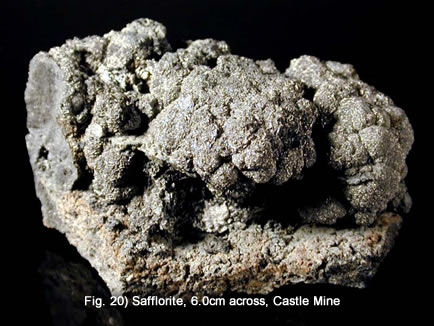

Safflorite This cobalt arsenide occurs throughout the district in most of the veins and is the most common arsenide (Petruk et al., 1971d). It is a common constituent of the arsenide rosettes and is difficult to distinguish, by eye from the other white arsenides. It can be found as irregular grains in arsenide masses or as lath-like crystals arranged radially around cores of “rosettes”. Many fine specimens have been recovered by removing carbonates from vein sections to reveal botryoidal safflorite in handsome specimens. (See also Fig. 70)
Scorodite Scorodite occurs as brown to honey brown earthy to glassy masses lining vugs in deeply weathered Fe-Co and Co-Fe assemblages. It is common but often not recognized. It has not been found in crystals yet. The presence of scorodite but no erythrite is a sure sign that the silver metallic mineral associated with the scorodite is lollingite. (Pers. Comm. R. Mielke, 2015) (See Fig. 71)
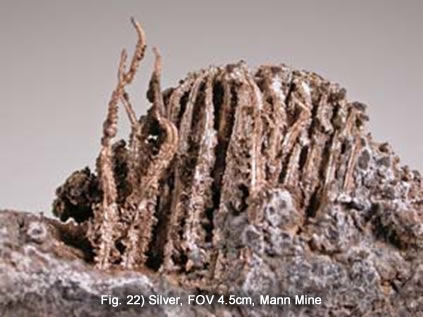
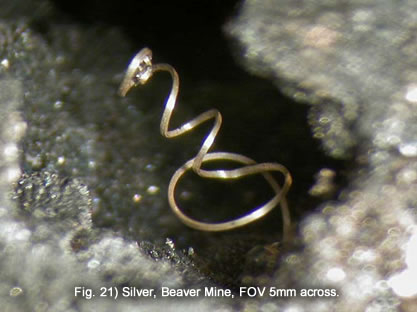
Silver Native silver is by far the most important silver mineral present in the ores of the Cobalt-Gowganda areas. Petruk (1971b) has recorded three distinctly different types that can be distinguished on the basis of chemistry and crystal structure. Petruk describes “Silver 1” as the main type, containing some antimony and mercury in solid solution. “Silver 2” contains large amounts of antimony and mercury, and normal native silver, without appreciable amounts of antimony or mercury, forms at a late stage in the ore genesis as wires, veinlets, and disseminated grains. Allargentum is a distinct mineral species occurring as discrete grains with silver 1 and as exsolution lamellae in silver 2. The two types of silver, silver 1 and silver 2 cannot be distinguished, visually, from "normal" silver unless the latter occurs as wires.
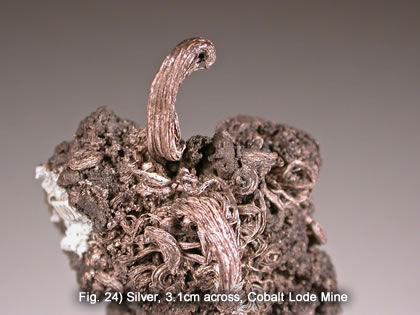
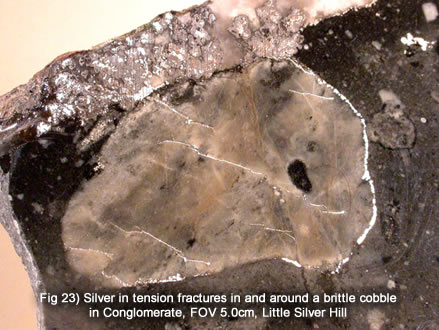
The Cobalt-Gowganda camp produced some 600,000,000 ounces of silver and huge masses of the mineral were encountered and recorded during mining. "Silver Sidewalk" was a descriptive name given to a vein near Kerr Lake, giving an idea of the scale of some of the silver masses.

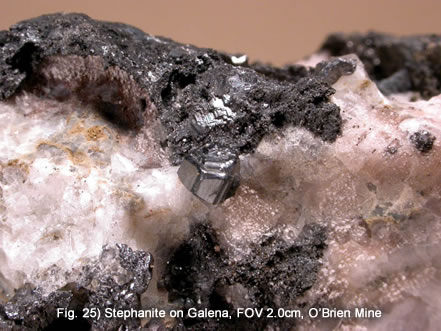
Unfortunately, large, spectacular silver wire specimens, similar to those of Kongsberg, Norway, were not found. However, smaller wire silver specimens have been preserved in various collections and many are extremely attractive. Large silver plates weighing up to hundreds of pounds are known.
Despite the millions of ounces of silver that have been encountered at Cobalt, distinct crystals of silver are rarely found. Arborescent growths are common, however, and beautiful, branching aggregates of silver are often found, almost always with a coating of nickel or cobalt arsenides that can be thin or so thick as to form the majority of the vein. These types of dendritic silver are found at many mines in the Cobalt-Gowganda mining camp.
“Herringbone” silver is also frequently encountered. This style of arborescent growth differs from the previously described arborescent growths in that the silver crystals are straight and have formed in delicate comb-like aggregates, resembling the ribs of herring fish. These delicate aggregates, which are really branching, twinned crystals, are almost always coated with cobalt-nickel arsenides. It has been observed that this type of dendritic silver is usually encased in calcite when from Gowganda and dolomite when from Cobalt or Casey Township (Mielke, 2015) Collectors are fascinated by the patterns exhibited when such high-grade samples are cut with a diamond saw. Sawn slices of this type of high-grade also find use as a lapidary material. “Herringbone” silver can be found at many of the mines from the Gowganda area.
Very nice pseudomorphs of cobalt-nickel arsenides after dendritic silver are commonly found in the Cobalt-Gowganda Mining Camp. It often appears that the silver has been re-mobilized out of the cobalt-nickel arsenide coatings to leave epimorph-type pseudomorphs. Often, even though the silver has been remobilized out of the epimorphs, it is present as veinlets of solid silver in the calcite vein near the epimorphs. (See also Figs. 72-86)
Skutterudite Skutterudite occurs as small euhedral crystals in many mines of the Cobalt-Gowganda area mines and in excellent crystals at some mines. Superb, 0.4 inch crystals occurred at the Temiskaming and the Keeley mines. The best crystals have been collected at the Hudson Bay (Rustex) mine, near Gowganda. Skutterudite also often occurs in excellent botryoidal masses. (See Figs. 87, 88)
Sphalerite This mineral is not that common in the veins at Cobalt although it occurs in significant quantities in the Keewatin interflow volcanics that can host silver veins. Royal Ontario Museum specimen M13276 from the La Rose mine shows lustrous micro-crystals.
Stephanite This sulfosalt is relatively common in small crystals and in massive form in Cobalt area ores. Most stephanite crystals are 0.20 inches in the longest dimension or less however one specimen, M47444, from the Keeley mine in the Royal Ontario Museum collection displays a prominent 26mm crystal. The stephanite crystals are oftenpartially coated with pseudomorphs of acanthite after argentite crystals.
Stromeyerite Stromeyerite is not known to occur in crystals at Cobalt. It occurs at several mines as veinlets and blebs in rock and carbonate/quartz veins (Petruk et al., 1971d). Most specimens, initially identified as stromeyerite by eye, by collectors, usually turnout to be bornite or tetrahedrite.
Tetrahedrite Usually massive and associated with native silver and most of the arsenide minerals both in the veins and wall rocks near the veins. Locally it forms masses up to 7-9cm across.
Ullmanite Ullmanite is not a common mineral at in the Cobalt-Gowganda silver veins. There is one specimen in the Royal Ontario Museum collection M25565 from the Silver Bar mine that consists of 3-4mm crystals embedded in nickeline. As well, It has been found as anhedral grains on sponge silver at the Nipissing 404. R. Mielke has found crude crystals from the Hellens-Eplett Mine. Ullmanite can be distinguished by its excellent cleavage, slightly darker silver colour than other arsenides and a slight bluish tarnish ( not always present). However the only reliable way of distinguishing it is with EDS or XRD (Per Comm. R. Mielke).
Xanthoconite This rare mineral is found in proustite rich areas of the veins in yellow-orange platy or diamond-crosss-sectioned crystals less than 1mm or so. On occasion, xanthoconite in mammillary aggregates of bladed crystals associated with proustite crystals have been found. (See Fig. 80)
Other Minerals A number of other minerals have been noted in various studies and examinations of specimens but not in significant quantities or quality. They are: anatase, arsenic, azurite, chalcocite, covellite, galenobismutite, garnierite, gold, marcasite, molybdenite, parkerite, pavonite, pentlandite (cobaltian), seigenite, spherocobaltite, smythite, violarite, wittichenite.
More Photographs and Mineral Information Below References.
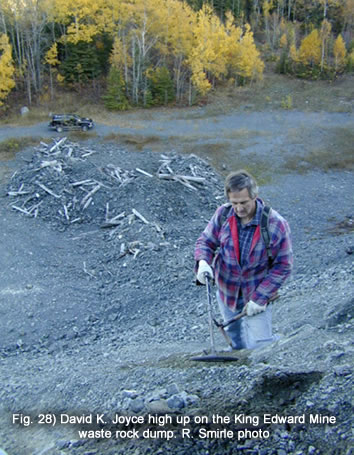
Mine Dumps Each mine in the Cobalt Camp had at least one “waste dump” and some had many, where barren rock from the workings was dumped. Luckily for mineral collectors, the miners sometimes missed chunks of high-grade and pieces of rock or vein containing varying amounts of silver and associated minerals and these ended up being mixed in with the “waste.” To this day, it is possible to comb through old waste dumps and find spectacularly rich, silver and arsenide specimens, although it is not as easy, now, as it once was. Mineral collectors have been “picking over” the dumps for many years and any silver that was easy to find on the tops of the dumps was found long ago. However, on occasion, today, the old dumps are disturbed when volumes of broken rock are taken as road fill or fill for other reasons. When this happens, fresh rock is exposed from deep within the waste dumps and sometimes, pieces of interesting mineralization are turned up after being hidden for many decades.
The use of metal detectors has helped collectors probe deeper into waste rock piles, to detect pieces of rock or vein material containing silver. By now, most old mine dumps have been swept with metal detectors to a depth of at least 2-3 feet or more. People with new-better technology metal detectors are probing deeper into the dumps and continually finding rich specimens. As well, if the rock dumps are disturbed for use as rock fill or other reasons, then fresh rock may be exposed which will enable the collector with a metal detector to find some nice specimens of silver and associated minerals at relatively shallow depths, again. Still it is amazing how people return to “picked over” rock dumps and somehow find nice specimens of high-grade ore even though, probably, many hundreds of collectors have been there before them!
One of the joys of collecting at Cobalt is stumbling over an old waste dump or portion of a waste dump of that has not been examined with a metal detector. It happens regularly by intrepid collectors! Sometimes past collectors have missed a dump simply because it was old and so leaf-covered nobody had noticed it. Other times, some volumes of dumps have had buildings built on them or collapse on them, making it difficult to dig or use a metal detector. Identifying an area like that often results in rich silver rewards.
It is relatively common to find chunks of high grade ore consisting of silver associated with arsenides and sulfides. It is more difficult to find leaf and plate silver. Wire silver was never very common at Cobalt and only on very rare occasions is significant wire silver found in waste rock dumps.
The unusual minerals such as proustite, stephanite, xanthoconite, etc., were really only found in-situ in the early workings. It is extremely rare to find well-formed crystals of these minerals in waste rock dumps, although it does happen. In reality, though, most all of the good crystals and specimens of these minerals came from blasted veins and rock, fresh from underground workings, many years ago.
Most people tend to focus on the silver or arsenides. It can also pay to look closely at fragments of calcite/dolomite or at mineralized joint planes, since there could be open spaces containing interesting, albeit, small crystals of some of the more rare or unusual minerals.
Glacial Float During the last ice age, before 10,000 or so years ago, giant ice sheets and glaciers covered all of northern Ontario. These ice sheets were under a hydrostatic head and ‘flowed” plastically, like rivers of ice against the bedrock. The moving ice sheets scoured the rock surface and tore out chunks of silver and arsenides from the Cobalt area veins along with much rock and rock particles, altogether known as glacial “drift” or “float”. As the glaciers moved, they transported the chunks of rock and veins away, “down drift” from the place that they originated. When the glaciers melted, the pieces of silver vein were dropped and buried along with boulders and ground up rock. Some spectacularly large pieces of glacial “float” silver have been found on the surface of the ground in the Cobalt area. In 1923, a glacial boulder weighing 1424 pounds, containing an estimated 11,000 troy ounce of native silver was found in Gillies Township (Smith, 1986) and can, currently be viewed at the Ontario Science Centre, Toronto. Many others have been found over the years. Recently, determined collectors with metal detectors have found some fantastic native silver glacial float, usually with the carbonates and arsenides completely or partially leached from around the silver by circulating ground water and oxidation. Such collecting is difficult in the dense bush and roots, down-drift from the silver veins.
In Situ Today, it is virtually impossible to collect silver or other interesting minerals in situ, in Cobalt. Any surface veins with any amount of valuable minerals were excavated sometime in the past. It is still possible to trace extensions of veins, along strike and see erythrite or annabergite stains in the rock. Most underground workings are below the water table and are flooded to surface. Very few are accessible and those that are, are not maintained and must be considered to be very dangerous.
Old Collections On occasion, old collections become available that include nice specimens of silver or associated minerals from the “heydays” of mining in Cobalt. Many past miners, geologists, engineers and mine managers have squirreled away high grade silver specimens or curious wire silver specimens amongst their collections or belongings. It can be great to stumble upon an available cache of old specimens in that manner.
Mineral Dealers A lot of specimens have been collected over the years. Keep an eye open for them at various mineral showa and on-line. There is a very large assortment of Cobalt-Gowganda specimens for sale on this website. Look under “Cobalt” in the main “Minerals” heading at https://djoyceminerals.com/pagefiles/minerals.asp .
Cobalt Museum
The Cobalt Mining Museum, in downtown Cobalt, has some great displays of silver and associated minerals from the Cobalt Area. As well, there are a number of displays of regional minerals, mining memorabilia, historical pictures, mining equipment and models. If you are really interested in the mines, minerals and history of the Cobalt Camp, you need to make time to visit for a couple of hours, if you are in the area. For more information check out www.facebook.com/The-Cobalt-Mining-Museum-796782930373965/
Current Land Access
Access to old mine operations and dumps is varied. Some landowners and claimholders do not want trespassers under any circumstances. Others don’t mind visiting collectors, at all. There are many old mine dumps, most on private property and the owners are constantly changing. It is best to research and seek permission to collect in Cobalt.
The Cobalt-Gowganda area is one of the most prolific silver producing areas of the world and has been a source of many interesting mineral specimens for over 100 years! I hope that you find this article interesting, informative and a good reference. There is another article on this website; “Mines of the Cobalt-Gowganda Area” at https://djoyceminerals.com/pagefiles/articles_cobaltmines.asp , that lists all of the mines in the Cobalt-Gowganda Area, their production, location and anecdotes about some of them.
There are a number of people that helped or gave me valuable information to make this article more useful and relevant. I’d like to thank staff of the Royal Ontario Museum, especially Dr. Kim Tait, that were so involved with the first article that was prepared for the Mineralogical Record, Volume 43, Number 6. Vince Vertolli, made a great contribution with the writing of the geology section of that article, which has been used again, here. Finally, I’d like to thank all of my northern Ontario Cobalt-collector friends such as Gil Benoit, Tony Bishop, Jason Duke, Peter Lickley, Jim Pauls, Roger Poulin and Roger Smirle, who, whether they know it or not, have somehow contributed to this article.
All people interested in the mines and minerals of the Cobalt-Gowganda areas are indebted to Reiner Mielke and Maggie Wilson. Through their intense interest in the Cobalt-Gowganda area, they have found numerous minerals new to the areas or superb examples of many known minerals, confirmed the mineral identities at their own cost and initiative, photographed them and made their finds available to the public through mindat.org and this article. Our knowledge of the mineralogy of the Cobalt-Gowganda area is much more complete and thorough because of their work.
ANDREWS, A.J., OWSIACKI, L., KERRICH, R. and STRONG, D.F. (1986). The silver deposits at Cobalt and Gowganda, Ontario. I: Geology, petrography and whole-rock geochemistry. Canadian Journal of Earth Sciences, 23, 1480-1506.
APPLEYARD, E.C. (1980). A preliminary metasomatic assessment of laminated siltstones at the Siverfields mine, Cobalt, Ontario, In Geoscience Research Grant Program, Summary of Research, 1979-1980, Ontario Geological Survey. Miscellaneous Paper 93, 1-10.
BASTIN, E.S. (1939) The nickel-cobalt-native silver ore type. Economic Geology, 34, 1-40.
BOYLE, R.W. and DASS, A.S. (1971). The origin of the native silver veins at Cobalt, Ontario. In The silver-arsenide deposits of the Cobalt-Gowganda region, Ontario. Canadian Mineralogist, 11 (1), 414-417.
CORFU, F. and ANDREWS, A.J. (1986) A U-Pb age for mineralized Nipissing diabase, Gowganda, Ontario. Canadian Journal of Earth Sciences, 23(1), 107-109.
DAVIS, H.P. (1910) The Davis handbook of the Cobalt silver district with a manual of incorporated companies. Published by The Canadian Mining Journal.
GOODZ, M.D., WATKINSON, D.H., SMEJKAL, V. AND PERTOLD, Z. (1986) Sulfur-isotope geochemistry of the silver-sulpharsenide vein mineralization, Cobalt, Ontario. Canadian Journal of Earth Sciences, 23, 1551-1567.
INNES, D.G. AND COLVINE, A.C. (1979). Metallogenic development of the eastern part of the Southern Province of Ontario, In Summary of Field Work, 1979, Ontario Geological Survey. Miscellaneous Paper 90, 184-189.
JAMBOR, J.L. (1971a) General geology. In The silver-arsenide deposits of the Cobalt-Gowganda region, Ontario. Canadian Mineralogist 11(1), p. 1-7.
___________ (1971c) Spotted chloritic alteration. In The silver-arsenide deposits of the Cobalt-Gowganda region, Ontario. Canadian Mineralogist 11(1), 305-319.
___________ (1971d) Origin of the silver veins of the Cobalt-Gowganda region. In The silver-arsenide deposits of the Cobalt-Gowganda region, Ontario. Canadian Mineralogist 11(1), 402-423.
JOYCE, D.K., TAIT, K., Vertoli, V., Back, M. and Nicklin, I. (2012), The Cobalt Mining District, Cobalt, Ontario, Canada. Mineralogical Record, Volume 43, Number 6 (Nov-Dec)., 685-713
KERRICH, R., STRONG, D.F., ANDREWS, A.J., AND OWSIACKI, L. (1986) The silver deposits at Cobalt and Gowganda, Ontario. III: Hydrothermal regimes and source reservoirs – evidence from H, O, C and Sr isotopes and fluid inclusions. Canadian Journal of Earth Sciences, 23, 1519-1550.
MIELKE, R., (2009-2016) Personal Communication over several years
MILLER, W.G. (1913) The cobalt-nickel arsenides and silver deposits of Temiskaming (Cobalt and adjacent areas). Ontario Bureau of Mines. XIX(II), 4th Edition.
___________ (1905) The Cobalt-Nickel Arsenides and Silver Deposits of Temiskaming. Report of the Bureau of Mines, 1905 Part II, pg. 6.
___________ (1904) Cobalt-nickel arsenides and silver. Report of the Bureau of Mines, XIII(I), 96-103.
MURPHY, J.P. (1977) Yankee takeover at Cobalt! Highway. Bookshop Press, Cobalt, Ontario, 200 pp.
MOORE, E.S. (1955) Geology of the Miller Lake portion of the Gowganda silver area. Ontario Department of Mines. 64(5), 1-41.
PETRUK, W., CABRI, L.J., HARRIS, D.C., STEWART, J.M., and CLARK, L.A.(1970) Allargentum redefined. Canadian Mineralogist 10, 163-172.
____________, JAMBOR, J.L., AND BOYLE, R.W. (1971a) History of the Cobalt and Gowganda Area. In The silver-arsenide deposits of the Cobalt-Gowganda region, Ontario. Canadian Mineralogist 11(1), 1-7.
____________ (1971b). Mineralogical characteristics of the deposits and textures of the ore minerals. In The silver-arsenide deposits of the Cobalt-Gowganda region, Ontario. Canadian Mineralogist, 11(1), 108-139.
____________ and STAFF (1971c) Characteristics of the sulfides. In The silver-arsenide deposits of the Cobalt-Gowganda region, Ontario. Canadian Mineralogist, 11(1), 196-231.
____________, HARRIS, D.C. and STEWART, J.M. (1971d) Characteristics of the Arsenides, Sulpharsenides, and Antimonides. In The silver-arsenide deposits of the Cobalt-Gowganda region, Ontario. Canadian Mineralogist 11(1), 150-186.
____________, HARRIS, D.C., CABRI, L.J. and STEWART, J.M. (1971e) Characteristics of the Silver-Antimony Minerals. In The silver-arsenide deposits of the Cobalt-Gowganda region, Ontario. Canadian Mineralogist 11(1), 193-194.
RADCLIFFE, D. and BERRY, L.G.(1971) Clinosafflorite: a monoclinic polymorph of safflorite. Canadian Mineralogist 10, 877–881.
SAMPSON, E. and HRISKEVICH, M.E. (1957) Cobalt-arsenic minerals associated with aplites, at Cobalt, Ontario. Economic Geology 52, 60-75.
SEJKORA, J., HAWTHORNE, F.C., COOPER, M.A., GRICE, J.D., VAJDAK, J., and JAMBOR, J.L. (2009) Burgessite, Co2(H2O)4[AsO3(OH)]2(H2O), a new arsenate mineral species from the Keeley mine, South Lorrain township, Ontario, Canada,. The Canadian Mineralogist 47, 159-164.
SERGIADES, A.O. (1968) Silver cobalt calcite vein deposits of Ontario. Ontario Department of Mines, Mineral Resources Circular No. 10, 498.
SKINNER, B.J., JAMBOR, J.L., and ROSS, M. (1966). Mckinstryite, a new copper-silver sulfide. Economic Geology 61, 1383-1389.
SMITH, P. (1986) Harvest From The Rock: a History of Mining in Ontario. MacMillan of Canada. 346 p., [24] p. of plates : ill., maps.
SMYK, M.C. AND WATKINSON, D.H. (1990) Sulfide remobilization in Archean volcano-sedimentary rocks and its significance in Proterozoic silver vein genesis, Cobalt, Ontario. Canadian Journal of Earth Sciences, 27, 1170-1181.
SPENCE, M.W. and FRYER, B.J. (2006) Hopewellian silver and silver artifacts from eastern North America. In gathering Hopewell: society, ritual, and ritual interaction. Springer, New York. 714–733.
WATKINSON, D.H. (1986). Mobilization of Archean elements into Proterozoic veins; an example from Cobalt, Canada. In Proceedings of the Conference on the Metallogeny of the Precambrian (IGCP Project 91), Geological Survey of Czechoslovakia (UUG), Prague, 133-138.
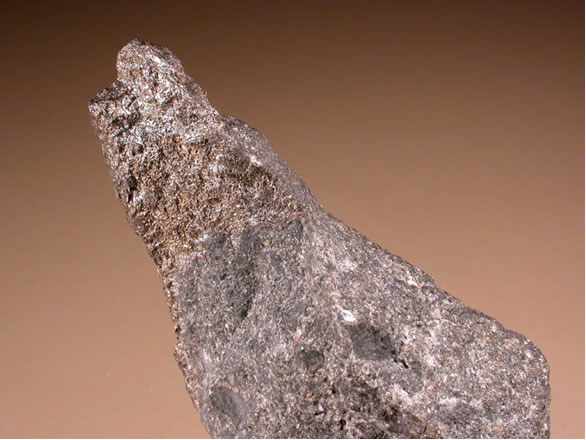
Fig. 29) Aikinite, Agnico Mine. 9.1x5.4x2.0cm Very rare. This specimen shows a dark, grey-black vein of aikinite that actually runs down the entire back of the specimen. The metallic vein is composed of very tightly packed small crystals of aikinite. I have seen another specimen, very similar to this, from the Silver Miller Mine, which has been analysed as lidstromite, which is a very similar mineral.
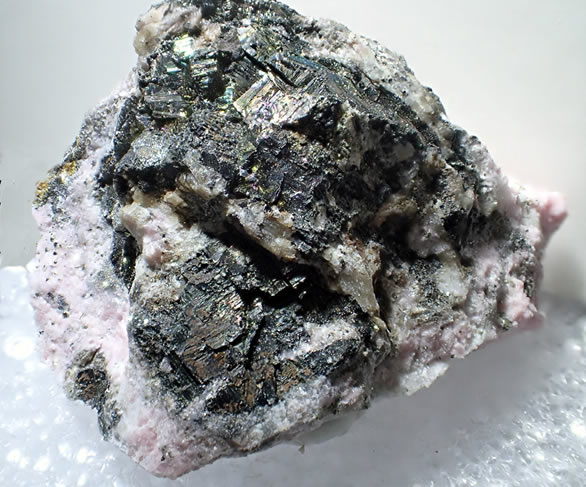
Fig 30) Alabandite, 2.0cm across. Very Rare This mass of black alabandite is embedded in pink rhodonite. R. Mielke and M. Wilson collection and photo.

Fig. 31) Allargentum, Silver, FOV 8cm or so across, Kerr Lake Mine, Coleman Township. The flat patches of allargentum lamellae exposed in massive native silver to 10mm. This mineral is probably not all that rare. Most people probably gloss over allargentum as silver. Kerr Lake Mine, Coleman Township. R. Mielke and M. Wilson collection and photo.
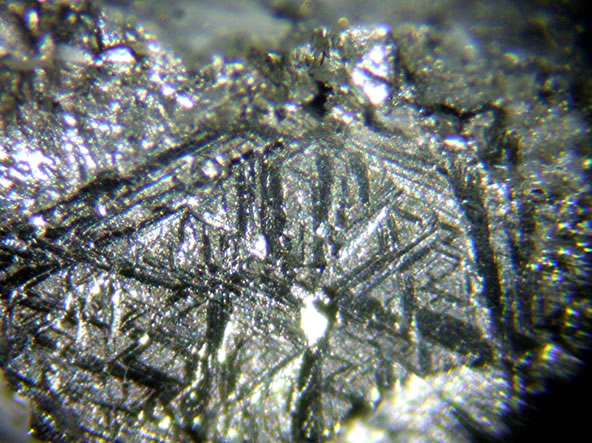
Fig. 32) Allargentum, FOV 2mm, Kerr Lake Mine, Coleman Township. This is a close-up of one of the parting surfaces shown in Fig. 31. R. Mielke and M. Wilson collection and photo.
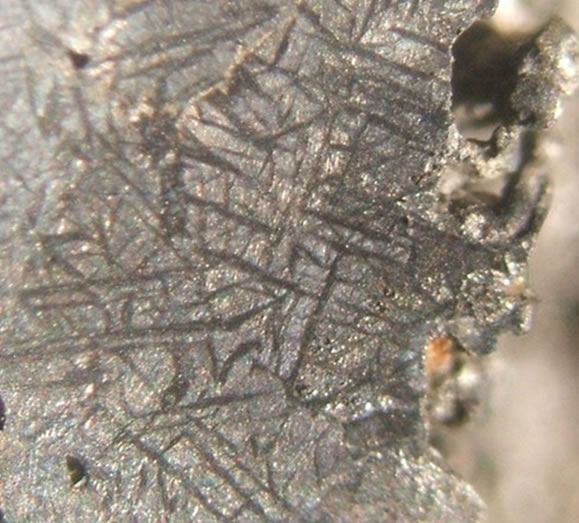
Fig. 33) Allargentum, Silver, FOV 2mm across. This specimen shows allargentum lamellae embedded in native silver and exposed by a saw cut and polishing and then etching of the surface with acid. R. Mielke and M. Wilson collection and photo.
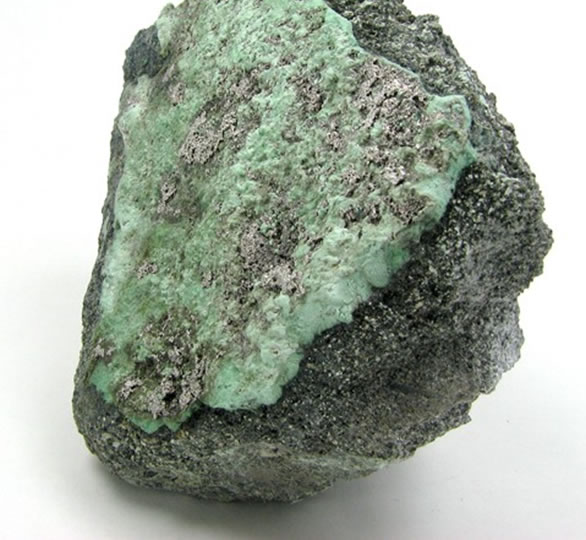
Fig. 34) Annabergite, Silver, 2.5cm across, Nipissing 404 Mine, Coleman Township. R. Mielke and M. Wilson collection and photo.
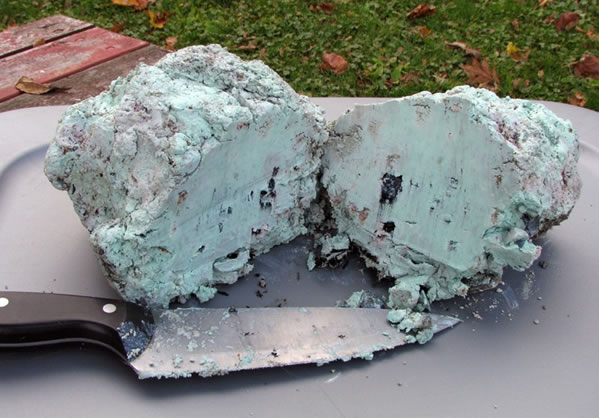
Fig. 35) Annabergite, Bellellen Mine, South Lorrain Township. A mass of plasticine-like annabergite unearthed from a waste-rock dump at this mine. Knife for scale. R. Mielke and M. Wilson collection and photo.
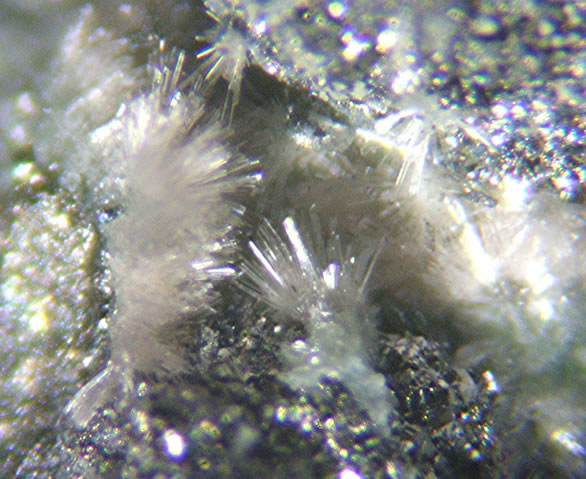
Fig. 36) Annabergite, FOV 1.5mm, Curry Mine, South Loraine Township. We are used to seeing annabergite as green crystals or powder. Not always! Here is an example of colourless crystals in a vug in massive pararammelsbergite. R. Mielke and M. Wilson collection and photo.
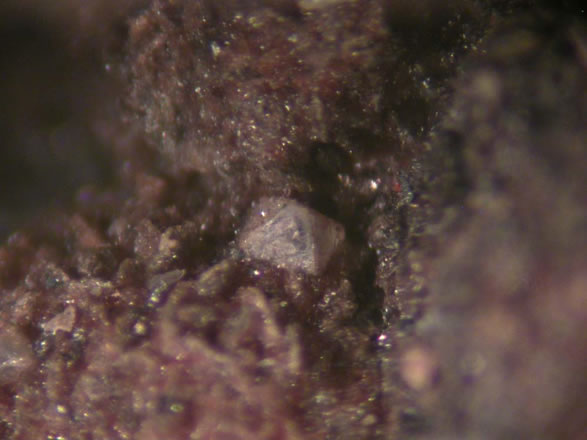
Fig. 37) Arsenolite, FOV 1mm, Beaver Mine, Coleman Township. This specimen has many sharp octahedra of arsenolite scattered about on what looks like partially oxidized safflorite.

Fig. 38) Bismuth, 10.0x4.2x1.6cm, O’Brien Mine, Coleman Township. This is actually a solid vein of native bismuth. If you could see close-up detail, you would see the casts of tiny calcite crystal terminations in the bismuth on both sides of the piece. The cleavages of individual crystals are up to 31mm across in this specimen.

Fig 39) Bismuth, 10.1x5.8x2.9cm, Silverfields Mine, Coleman Township. This vein material is composed of various arsenides, acicular tremolite and calcite with a thick zone of bismuth through the centre. Cleavage planes indicate that individual crystals of the bismuth are up to 33mm across.
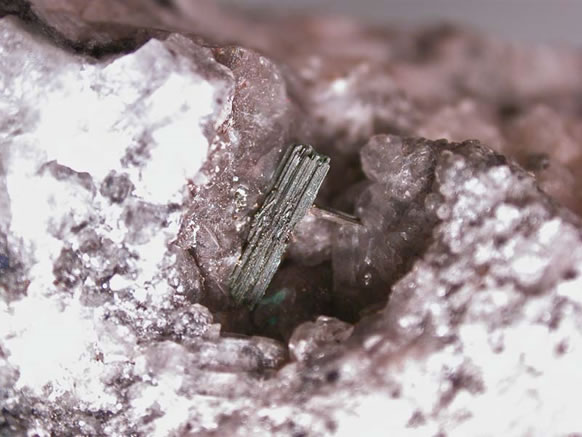
Fig. 40) Bismuthinite, Crystal 6mm long, Nipissing Mine, Coleman Township. An unusually large and thick bismuthinite crystal in a calcite crystal-lined vug in coarse, massive calcite. There are smaller bismuthinite crystals, tarnished deep-blue, in other vugs on the piece.

Fig. 41) Breithauptite on silver, 8.2x5.1x0.3cm, Lawson Mine, Coleman Township. This plate of native silver is slickensided and coated with, mostly, pink-metallic breithauptite on one side. Some nickeline as well. Old piece from the Arthur A. Cole collection.

Fig. 42) Breithauptite, FOV 1.5mm, Mining Corporation Mine, South Lorrain Township. A cluster of tiny pink-metallic breithauptite crystals associated with proustite and wire silver and a brownish-green early mineral. Originally from the Arthur A. Cole Collection with a 1922 notation on the label.

Fig. 43) Cerussite, FOV 1.5mm, Lawson mine Coleman Township. Associated with micro mimetite and anglesite. R. Mielke and M. Wilson collection and photo.
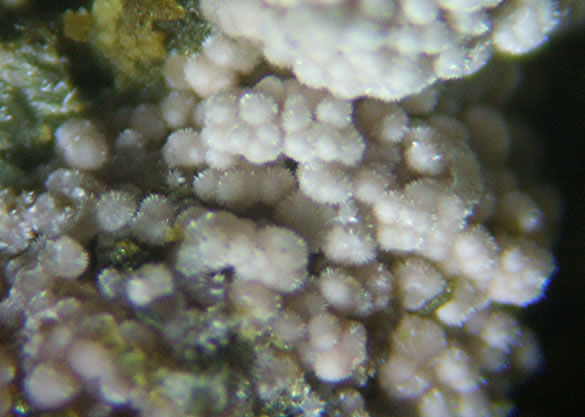
Fig. 44) Erythrite, FOV 2mm, Curry Mine, South Lorrain Twp. Almost white erythrite. We don’t see it like this very often. R. Mielke and M. Wilson collection and photo.
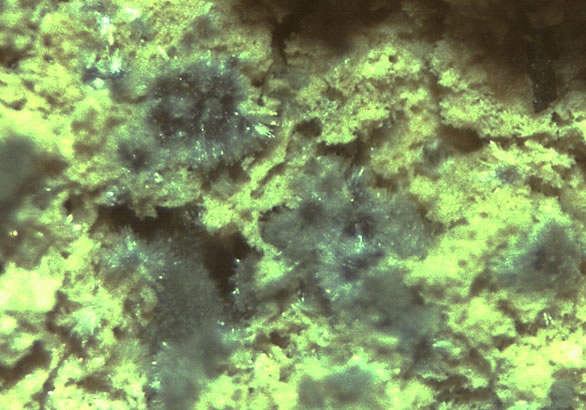
Fig. 45) Erythrite, Scorodite, FOV 2mm across, Lawson Mine, Coleman Township. Some grey erythrite that defies the colour stereoptype! From a vug in Löllingite. R. Mielke and M. Wilson collection and photo.
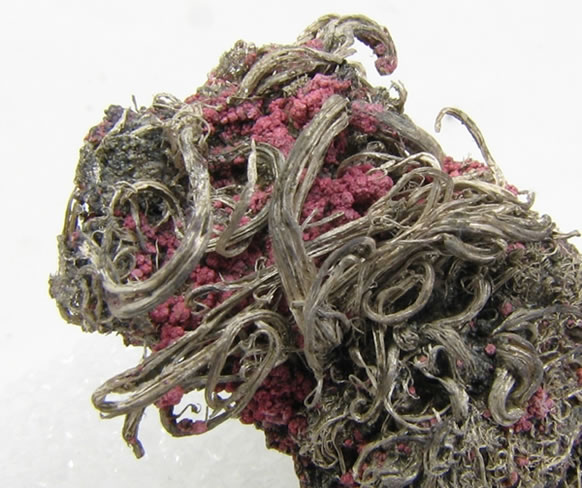
Fig. 46) Erythrite, Silver, FOV 25mm, Spherical aggregates of deep-pink erythrite amongst excellent wire silver, Nipissing 404 Mine. Coleman Township. R. Mielke and M. Wilson collection and photo.
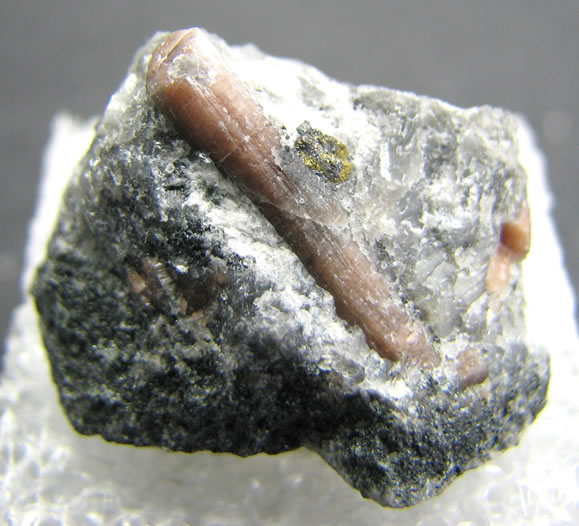
Fig. 47 (Fluor?)Apatite, matrix 25mm across, Castle Mine, Haultain Township (nr. Gowganda) A prism of apatite, associated with a little chalcopyrite in calcite. R. Mielke and M. Wilson collection and photo.

Fig. 48) (Fluor?) Apatite –Keeley Mine, South Lorrain Township. A segmented apatite crystal in calcite, chalcopyrite vein matrix. R. Mielke and M. Wilson collection and photo.
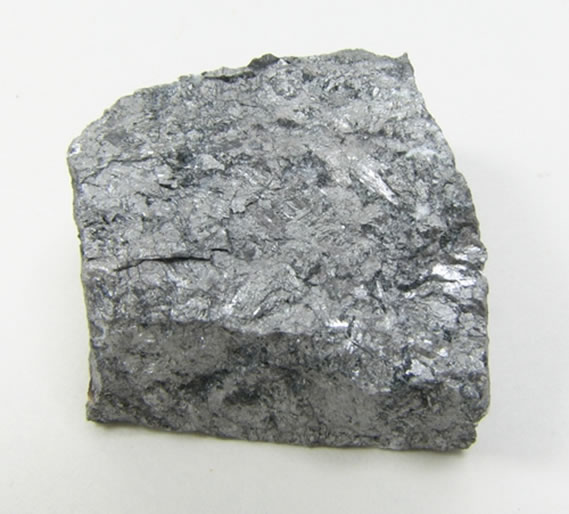
Fig. 49) Glaucodot, Lawson Mine, Coleman Township, 2.8x2.7x1.5cm
This specimen consists almost entirely of coarsely crystaline glaucodot with minor safflorite. Confirmed with EDS and XRF. You really have to analyse these types of specimens to be sure what they are! It is impossible to sight identify these “silvery” arsenides. They all look similar! R. Mielke and M. Wilson collection and photo.

Fig. 50) Goethite, FOV 2mm, Nova Scotia Mine, Coleman Township Golden needles of this mineral with secondary silver minerals and calcite. R. Mielke and M. Wilson collection and photo.

Fig. 51) Johannsenite, Rhodonite, 3.0cm across, Hellens-Eplett Mine, Bucke Township This specimen was extracted from a single fragment found on the dump of this mine by R. Mielke. He theorizes that the fragment did not originate from any silver-calcite veins but from VMS mineralization in the Archean basement rocks of the mine. R. Mielke and M. Wilson collection and photo.

Fig. 52) Kainosite-(Y), 2.5cm across, Castle Mine, Haultain Township (nr Gowganda). An exceptional kainosite crystal in calcite matrix. R. Mielke and M. Wilson collection and photo.
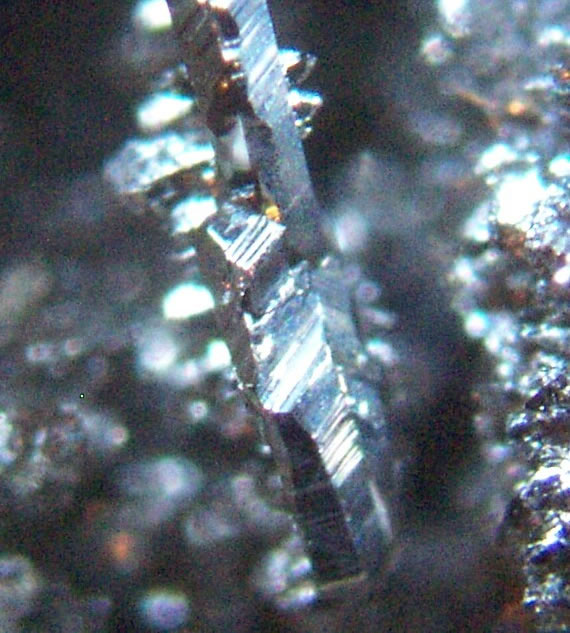
Fig. 53) Pararammelsbergite, 1mm crystals, Lawson mine, Coleman Township. Super-rare crystals of pararammelsbergite. R. Mielke and M. Wilson collection and photo.

Fig. 54) Orschallite, FOV 1mm, Nipissing 404 Mine, Coleman Township. A pseudocubic cystal of this unusual oxide zone mineral. R. Mielke and M. Wilson collection and photo.
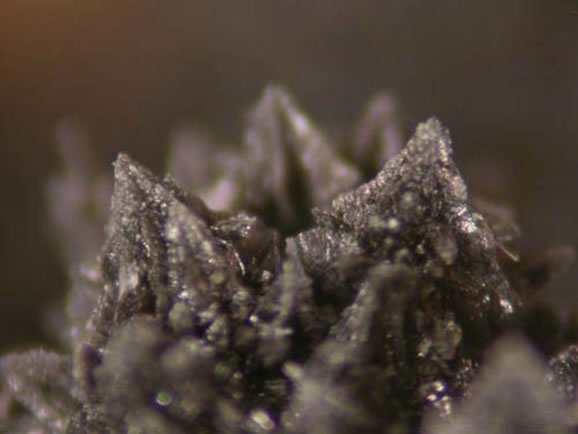
Fig. 55) Löllingite, FOV2mm, Siscoe Mine, Nichol Township (nr. Gowganda), Unusually good crystals of löllingite. Actually, these crystals are twinned “sixlings”. If you could look down the central axis of one of these crystal groups, it looks like a six-pointed star. Löllingite looks very much like arsenopyrite and is difficult to tell apart without a chemical or other analysis.
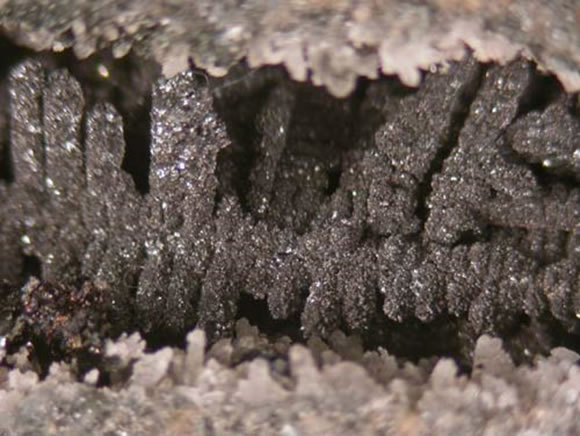
Fig. 56) Löllingite, Silver, FOV 16mm, Siscoe Mine, Nichol Township (nr. Gowganda). Crystallized silver at Cobalt, is usually enveloped in an arsenide(s) coating. One mineral that often coats silver is löllingite, usually in small tightly arranged crystals, like in this photo.
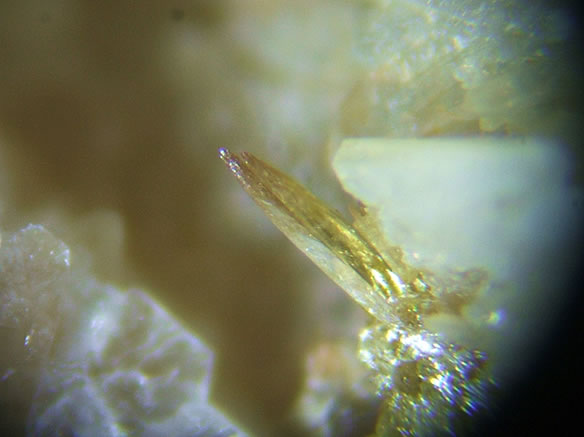
Fig. 57) Mimetite. Crystal is 1mm long, Lawson Mine, Coleman Township. A very unusual mineral in the Cobalt Camp. Here is a wonderful photo of an excellent crystal. R. Mielke and M. Wilson collection and photo
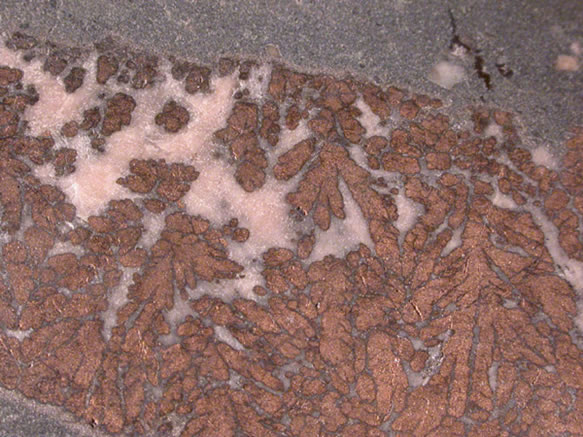
Fig. 58) Nickeline, FOV 55mm across, Cobalt. Nickeline often forms in lobular, botryoidal sorts of forms at Cobalt. These ones, shown in this sawn section are particularly elongated and sharply defined. Not exactly crystals but what? I have lost the exact locality for this specimen. If anyone knows, please tell me?
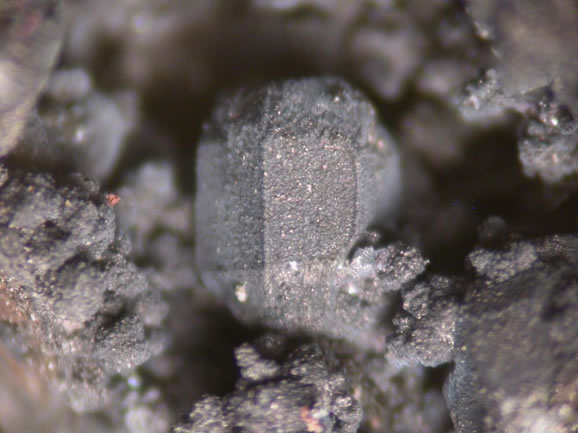
Fig. 59) Nickeline, 2mm crystal, Rustex (Hudbay Mine), Leith Township (nr. Gowganda). Superb crystal of nickeline that has a thin coating of another more silvery arsenide. The interior is all nickeline. We rarely see nickeline crystals this good from anywhere!

Fig. 60) Nickeline, Nickeline ps ?, FOV 20mm, Langis Mine, Casey Township. This image features larger botryoids of nickeline plus, in front, a pseudomorph of nickeline after some other prismatic mineral. Doesn’t look like nickeline and has a coating of a more silvery coloured arsenide.

Fig. 61) Nickeline, 30mm tall, Rustex (Hudson’s Bay) Mine, Leith Township. A bizarre form of nickeline showing a sort of plumose growth. The specimen was etched out of calcite/dolomite matrix. It has a coating of some other more silvery-coloured arsenide.
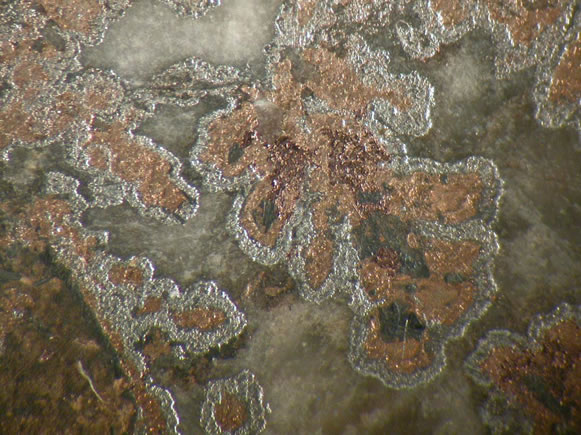
Fig. 62) Nickeline, Breithauptite, Rammelsbergite, FOV 15mm, Cobalt. A wonderful example of layered arsenide intergrowth in this sawn section. Note the pinkish metallic breithauptite included in the nickeline. You can really see the colour difference between nickeline and breithauptite in this photo. The silvery arsenide is rammelsbergite, possible pararammelsbergite.

Fig. 63) Nickeline, Silver, Breithauptite, FOV 50mm across, HiHo Mine, Coleman Township. An intergrowth of nickeline with a little pinkish breithauptite and veinlets of silver in this sawn and polished section of dolomite-brecciated ore.

Fig. 64) Nickeline, Silver, Trethewey Mine, Coleman Township. A chunk of nickeline laced through with native silver. The knob of nickeline on the top is mostly covering a thick ridge of silver.

Fig 65) Nickeline, FOV 11.0cm, Genessee Mine, Bucke Township. This specimen shows a vein of, mostly, solid nickeline, cutting through conglomerate.

Fig. 66) Polybasite, Safflorite, FOV 6mm, O’Brien Mine, Coleman Township. Sharp, black, pseudo-hexagonal, polybasite crystals.

Fig. 67) Proustite, FOV 23mm, O’Brien Mine, Coleman Township. Ruby-red, gemmy crystals of proustite in a calcite-lined cavity. It is tough to find proustite, these days but still possible!

Fig. 68) Rammelsbergite, Nickeline, FOV 3.5cm, Bellellen Mine, South Lorrain Township. An interesting, roughly zoned view of arsenide mineralization as seen through this sawn and polished section.
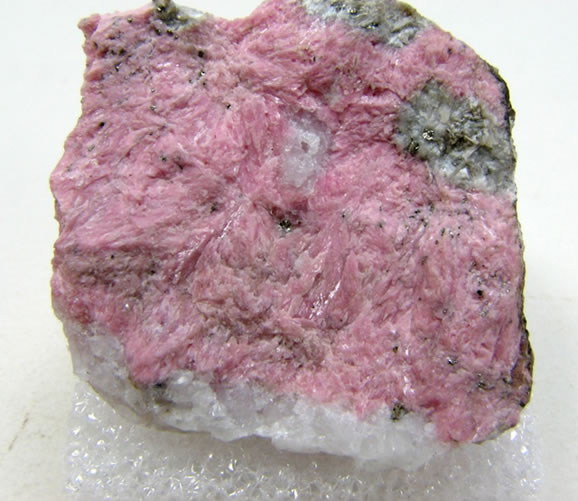
Fig. 69) Rhodonite, 30mm across, Hellens-Eplett Mine, Bucke Township. A very unusual mineral from the Cobalt area. It is felt that this material was raised from a sulphide deposit in the Archean volcanic basement rocks beneath the Hellens-Eplett Mine. R. Mielke and M. Wilson collection and photo.
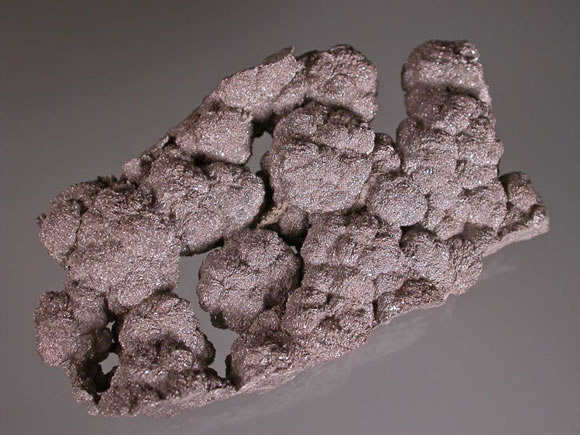
Fig. 70) Safflorite, 8.7x5.2cm, Beaver Mine, Coleman Township. A superb specimen of safflorite that has been exposed after the carbonate vein covering has been etched away.
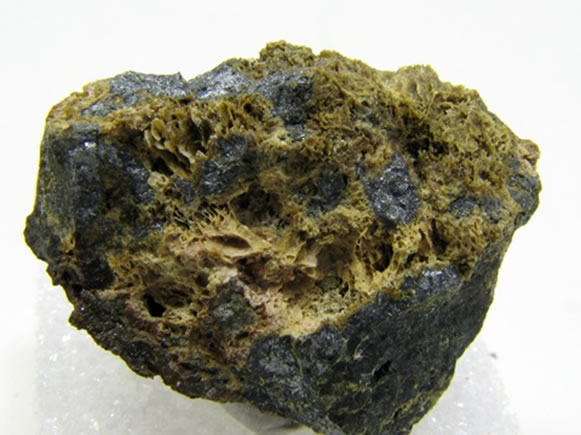
Fig. 71) Scorodite, Löllingite, 3.0cm across, Nipissing 404 Mine, Coleman Township. Glassy, porous scorodite in weathered löllingite. R. Mielke and M. Wilson collection and photo.
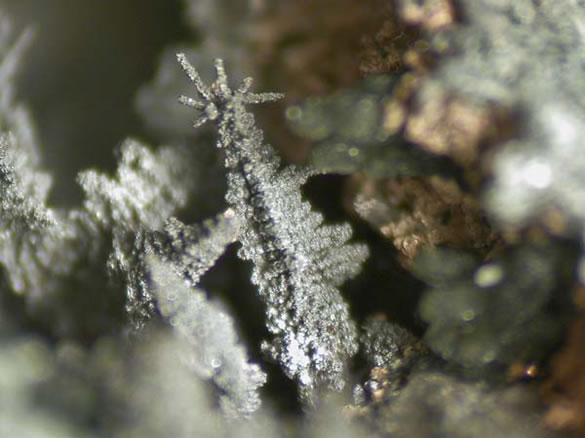
Fig. 72) Silver, Safflorite, FOV 10mm, Castle Mine, Haultain Township. A peculiar crystal aggregate! It seems to be a group of “herringbone” silver lightly coated with safflorite.

Fig. 73) Silver, Safflorite, FOV 8.0cm across, Capitol Mine, Haultain Township. A cavity showing many “herringbone” silver crystal groups thickly coated with safflorite.
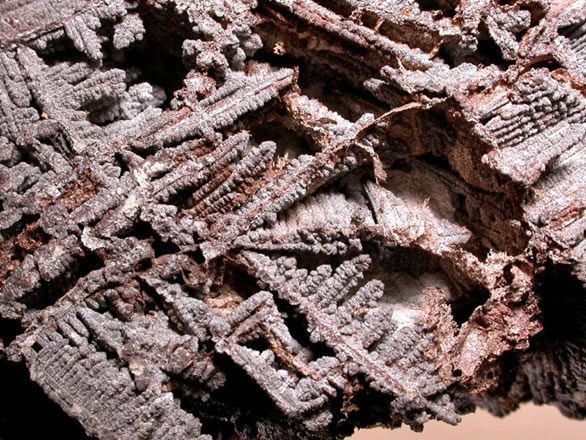
Fig. 74) Silver, Safflorite, FOV 3.5cm, Silverfields Mine, Coleman Township. Very well formed dendrites of silver. Lightly coated with safflorite with later silver veinlets cutting through. Of course, the carbonate that was present originally has been etched away.
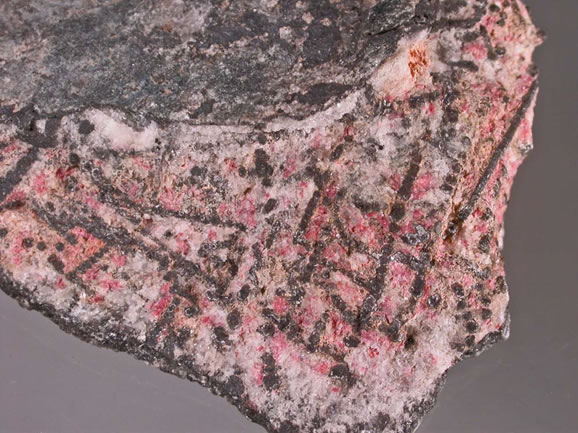
Fig. 75) Silver, Safflorite, FOV 6.5cm, McKinley-Darragh Mine, Coleman Township. Very long crystals of safflorite coated silver cut through the carbonate in this specimen. Weathering has caused erythrite to tint the specimen.
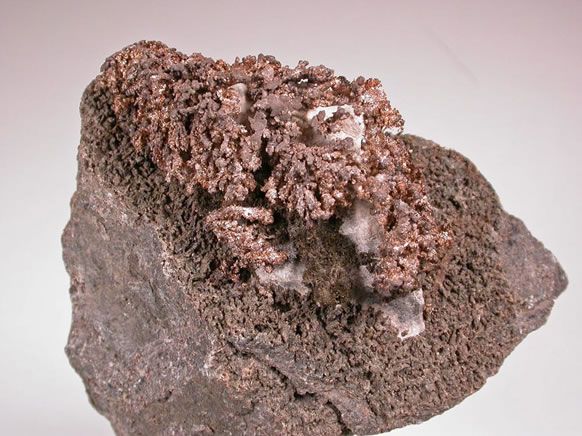
Fig. 76) Silver, 8.0cm across, Mann Mine, Milner Township. Very well crystallized silver that has been etched out of calcite on this specimen.
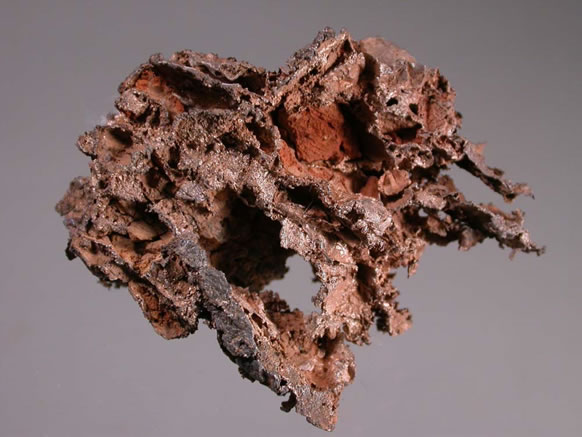
Fig. 77) Silver, Glacial Float, 5.6cm across, S. of Kerr Lake, Coleman Township. Excellent example of “float Silver”, silver that was ripped out of a vein by glaciers, dropped “down-drift” and weathered over the past 10,000 years or so, so that all of the carbonates and arsenides have been naturally dissolved away.
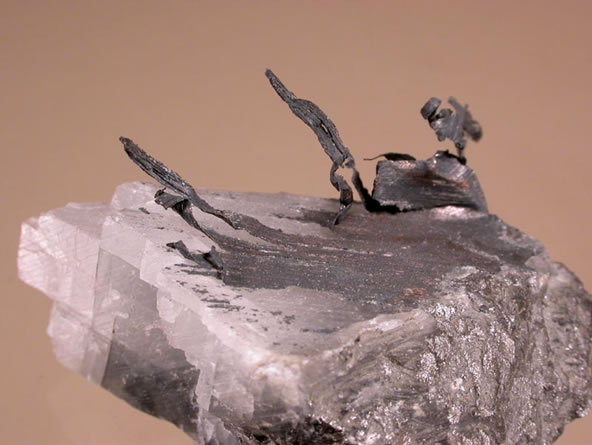
Fig. 78) Silver, Calcite, 4.5cm across, O’Brien Mine, Coleman Township. Paper thin ribbons of silver that formed in a cleavage plane in coarse calcite.
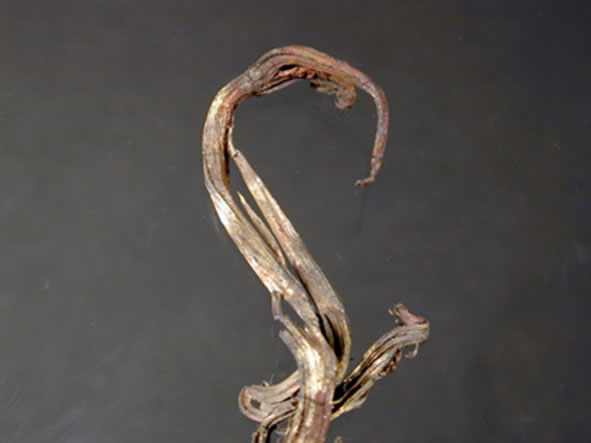
Fig. 79) Silver, 35mm tall, Keeley-Frontier Mine, South Lorrain. A sculptural wire of silver from this famous locality.
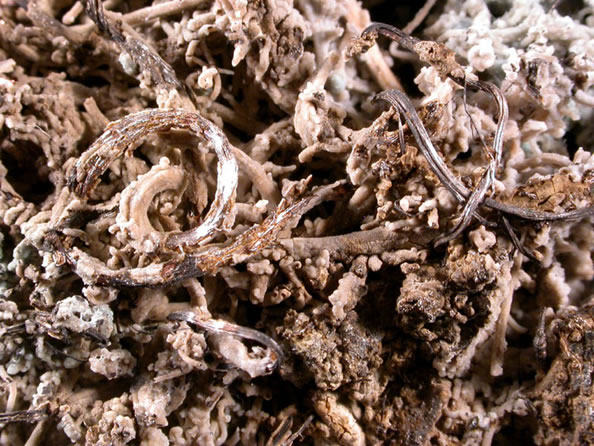
Fig. 80) Silver, FOV 30mm, O’Brien Mine, Coleman Township. Interesting view of a specimen that is totally composed of wire silver, except that each wire has been coated by a clay-like mineral. I have chipped a little of the coating mineral off to reveal a couple of the wires underneath.
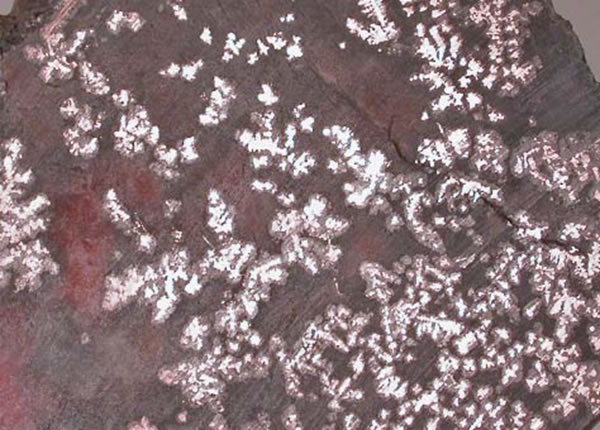
Fig 81) Silver, Calcite, Castle Mine, Haultain Township (nr. Gowganda), A sawn vein section showing bright, dendritic silver, shrouded in grey safflorite, embedded in orange and gray calcite. Orange calcite is not common but is seen occasionally, especially in the Gowganda area.
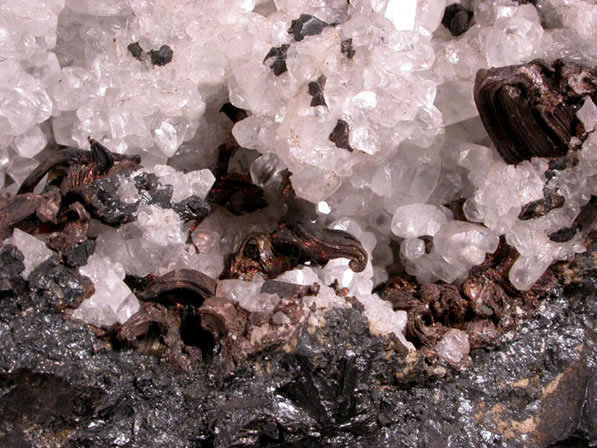
Fig. 82) Silver, Calcite, Acanthite ps Argentite, FOV 30mm, Coniagas Mine, Coleman Township. This is a rich specimen showing massive argentite with a large vug filled with wire silver and white calcite crystals. Here and there on the same specimen are stephanite crystals.
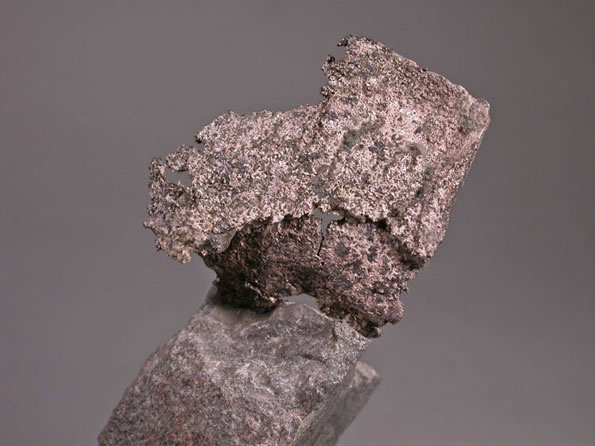
Fig. 83) Silver, 10.0cm tall, Silversides Mine, Coleman Township. This specimen shows a thick plate or leaf of solid silver protruding out of the top of rock matrix. There is a good chance you can find leaf silver like this one. Specimens like this are still found fairly regularly.
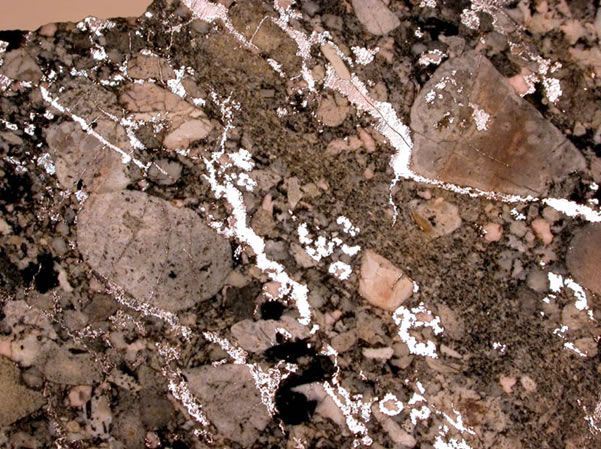
Fig. 84) Silver in coarse conglomerate, FOV 45mm, O’Brien Mine, Coleman Township. A fair bit of silver was mined, not in the carbonate-arsenide veins, themselves but in the “country rock” on either side of the veins. This sawn section is through conglomerate that was adjacent to a silver vein at the O’Brien Mine.
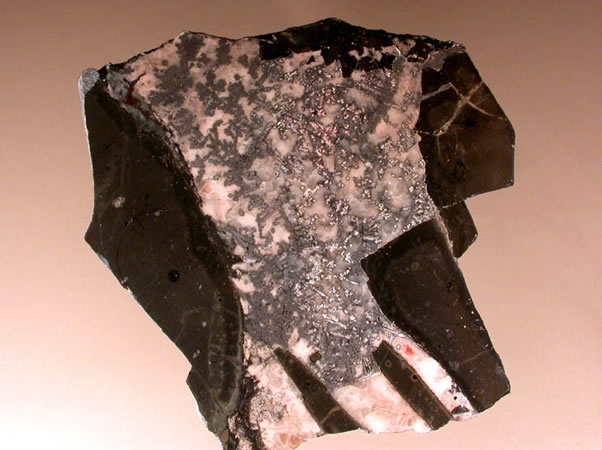
Fig. 85) Silver, Safflorite, 18.0 x 17.0cm, Langis Mine, Casey Township. A slice of rich dendritic silver with the typical arsenide coating, in this case, safflorite, in a brecciated carbonate vein setting.
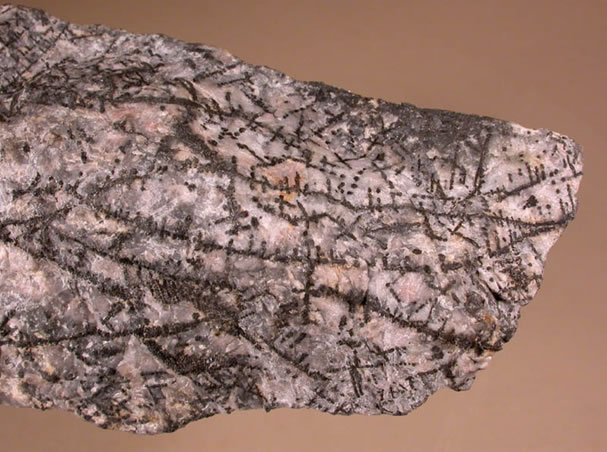
Fig. 86) Silver, FOV 9.0cm, Cobalt Lode Mine, Coleman Township. Excellent, long crystal aggregates of “herringbone” silver traverse dolomite vein matrix.

Fig. 87) Skutterudite, 9.2cm across, Nipissing 404 Mine, Coleman Township. Yes, skutterudite often occurs as botryoidal masses or interlayered with other arsenides.

Fig. 88, Skutterudite, 6.6cm across, Wetlauffer Mine, South Lorrain Township. Brecciated skutterudite with a little nickeline in dolomite. Looks like the skutterudite once was part of a botryoidal band deom the curved nature of the fragments.
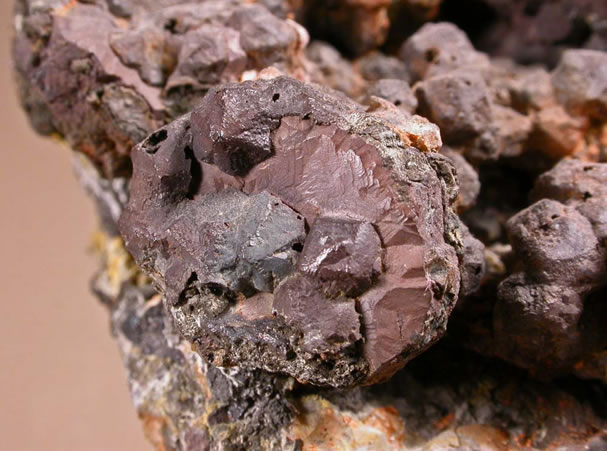
Fig 89) Stephanite, Acanthite ps argentite, FOV 24mm, Keeley Mine, South Lorrain Township. Stephanite crystals from this mine are the largest that I’ve seen in the Cobalt-Gowganda mining camp.
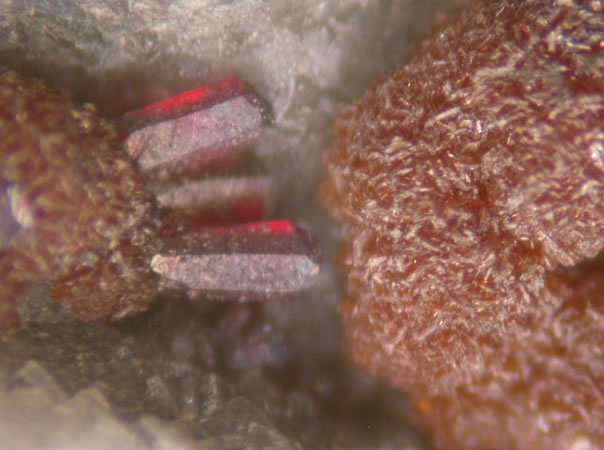
Fig. 90) Xanthoconite, Proustite, FOV 3mm, Cobalt, Coleman Township. This specimen has rich botryoidal aggregates of bladed xanthoconite crystals with a few proustite crystals. Originally from the Arthur A. Cole Collection. Apparently, he did not know what xanthoconite was. The label states “Ruby Silver, brown mineral”. A Dana localities for xanthoconite, at Cobalt are the Keeley and the La Rose Mines where, according to Dana, xanthoconite occured “as radial aggregates of tiny crystals associated with proustite”. Just like these!! My guess is that this specimen if from the La Rose Mine since Cole says it is from “Cobalt”, not South Lorrain Township.